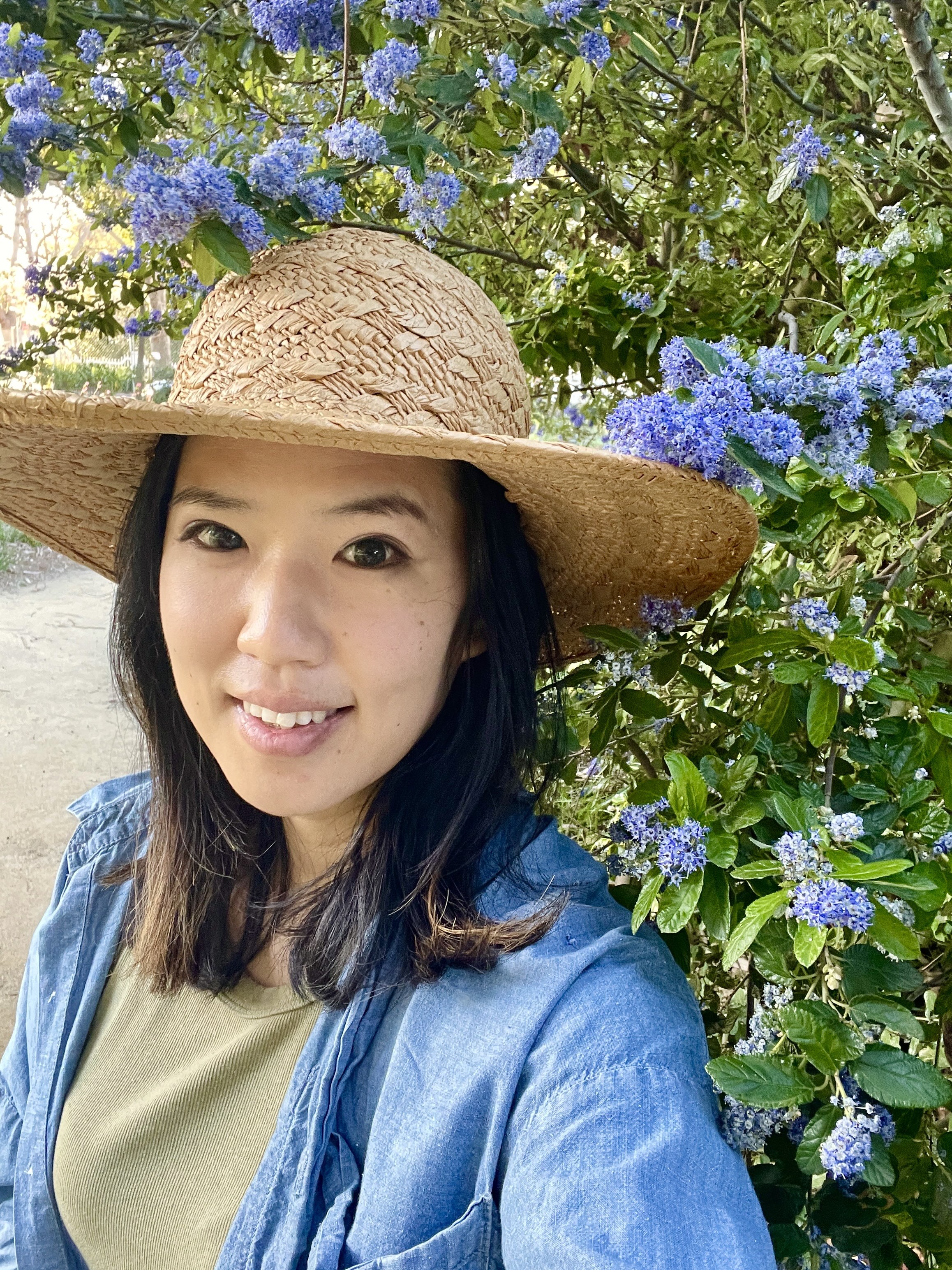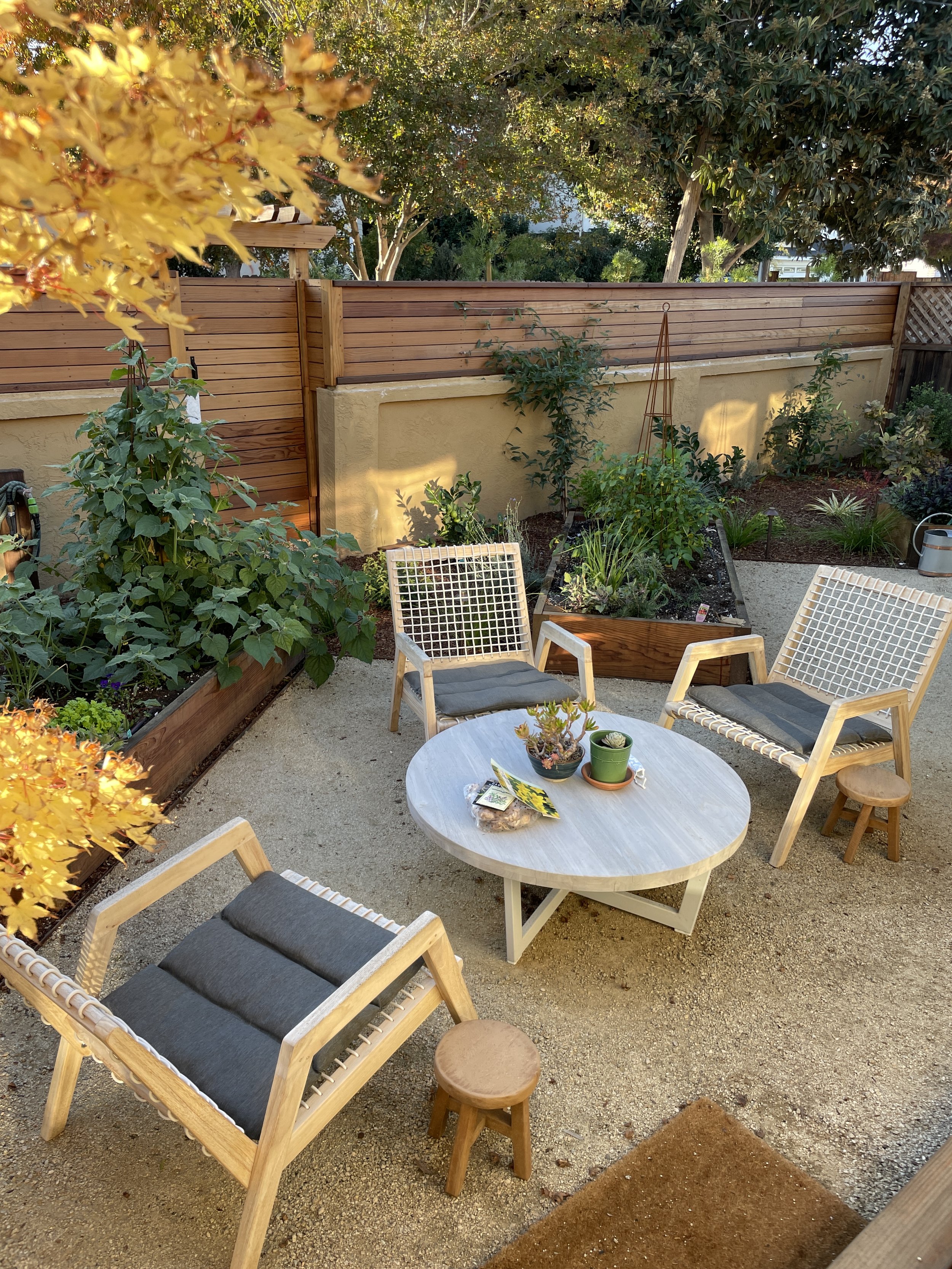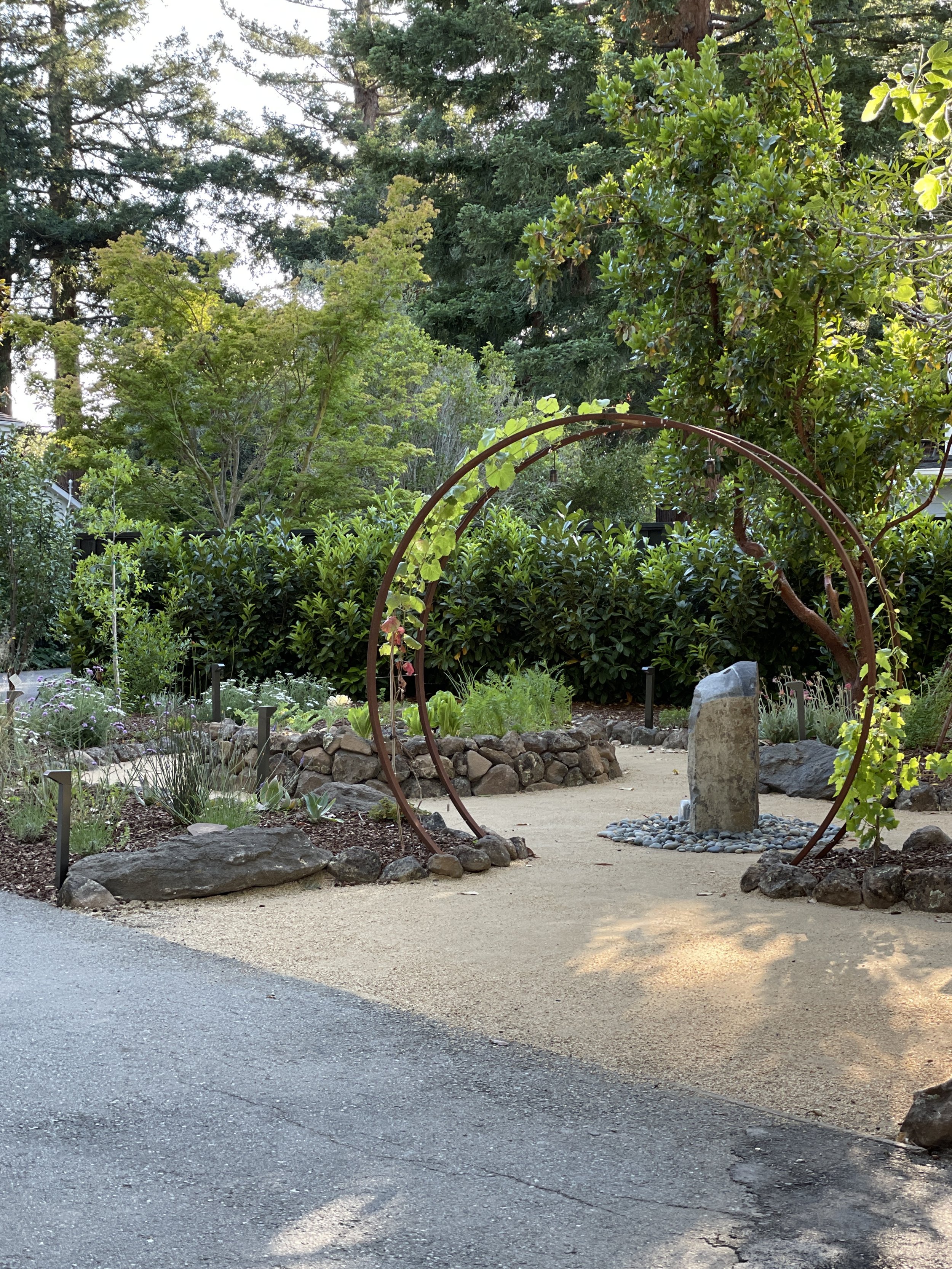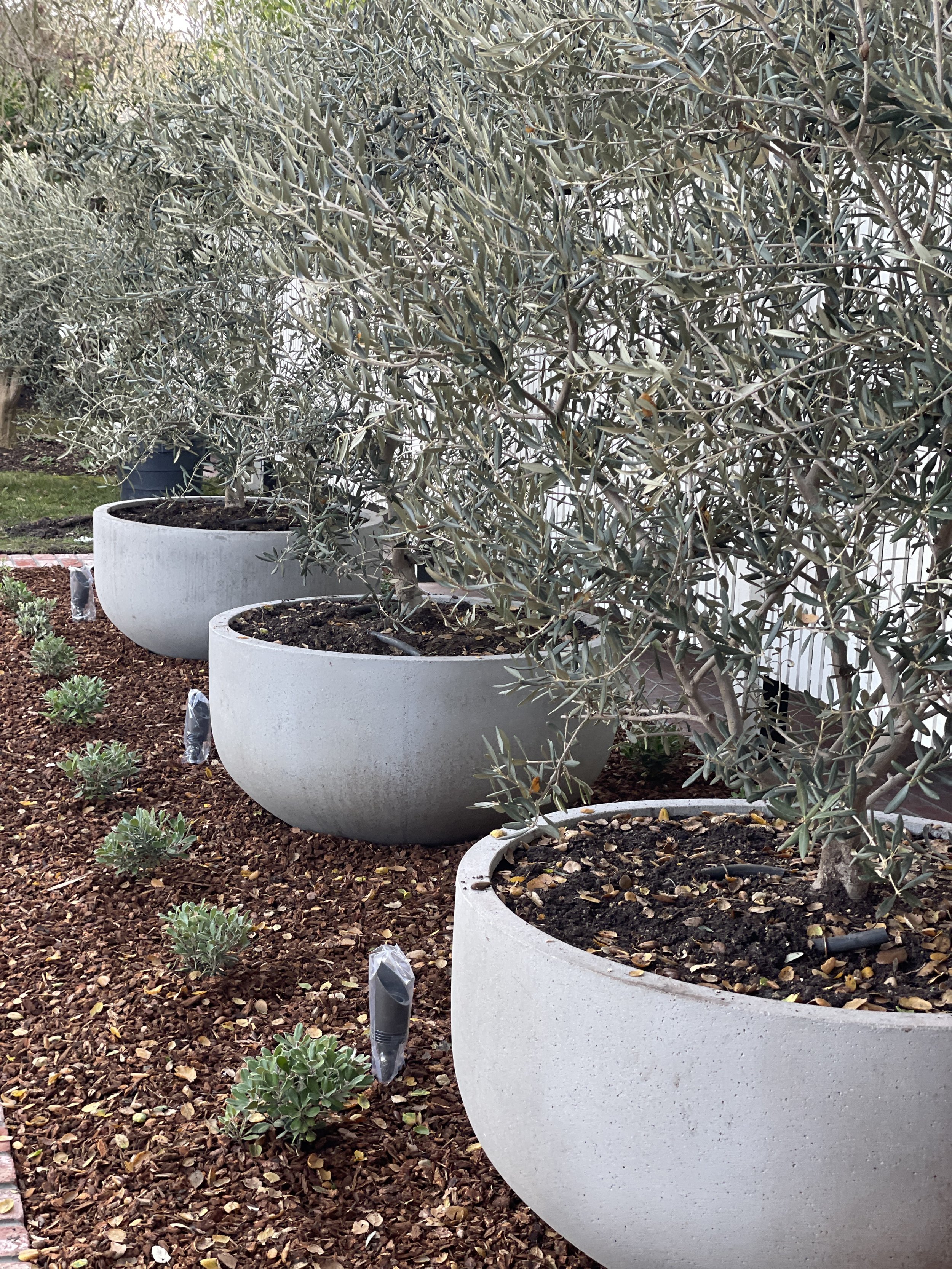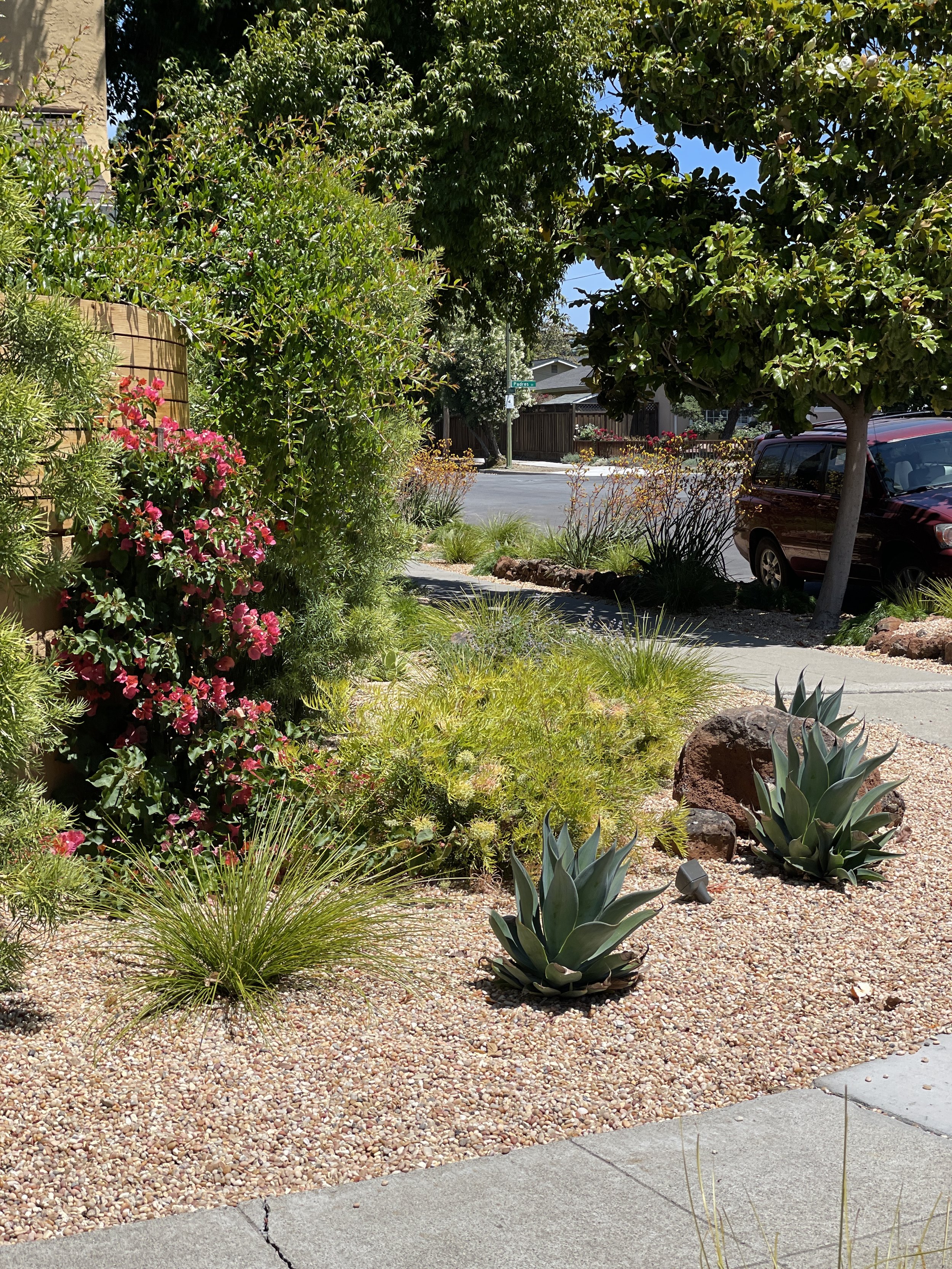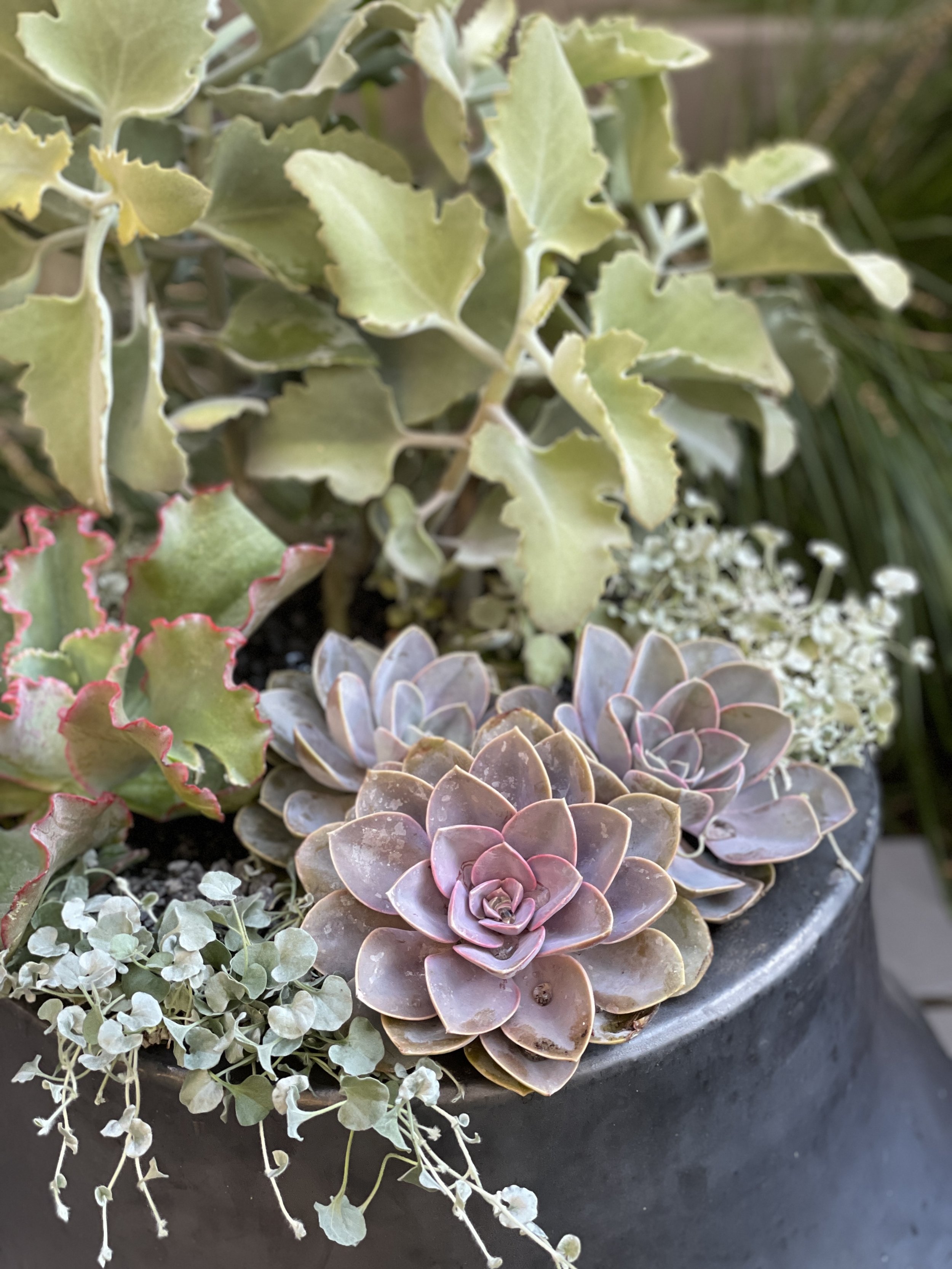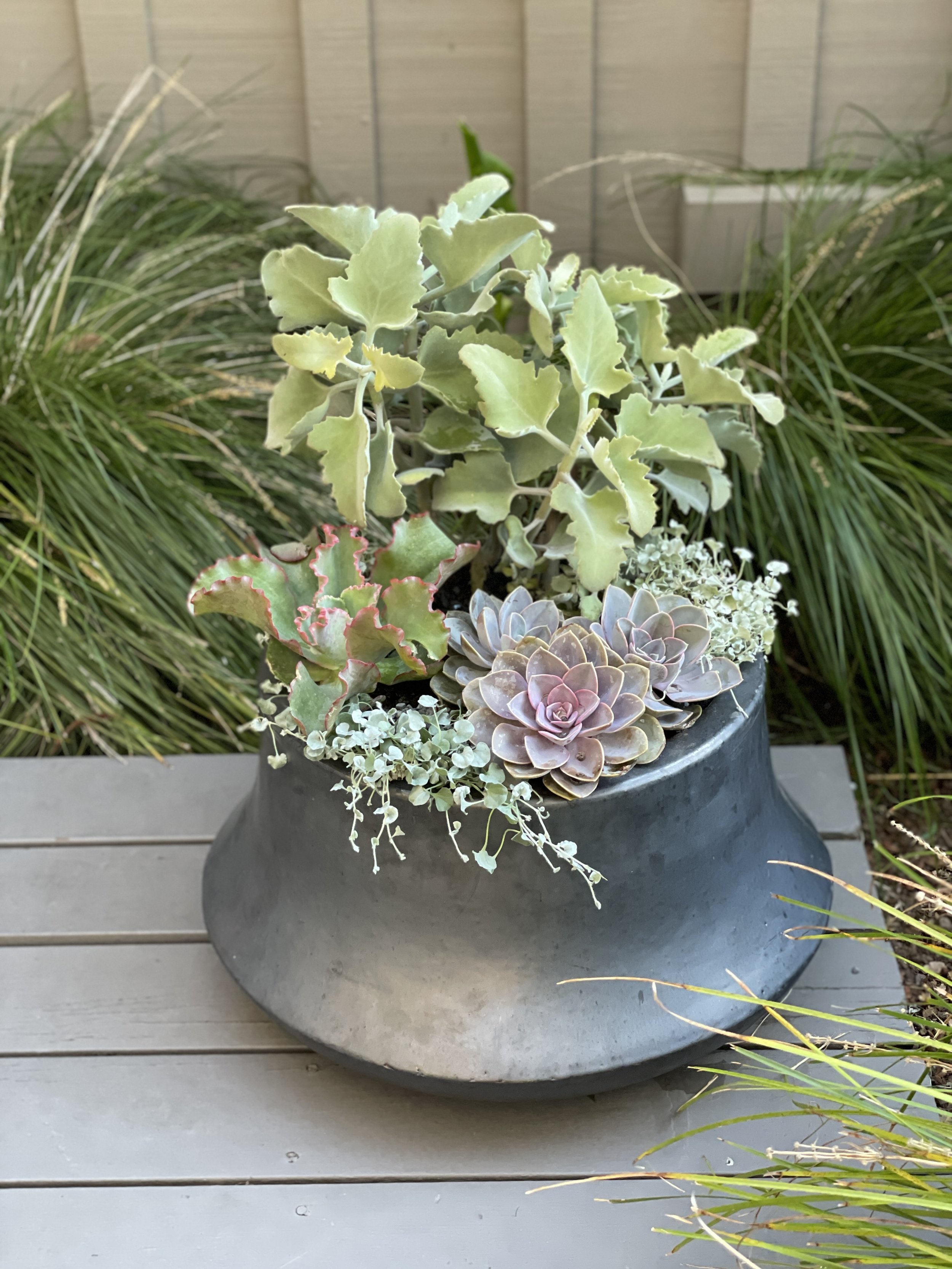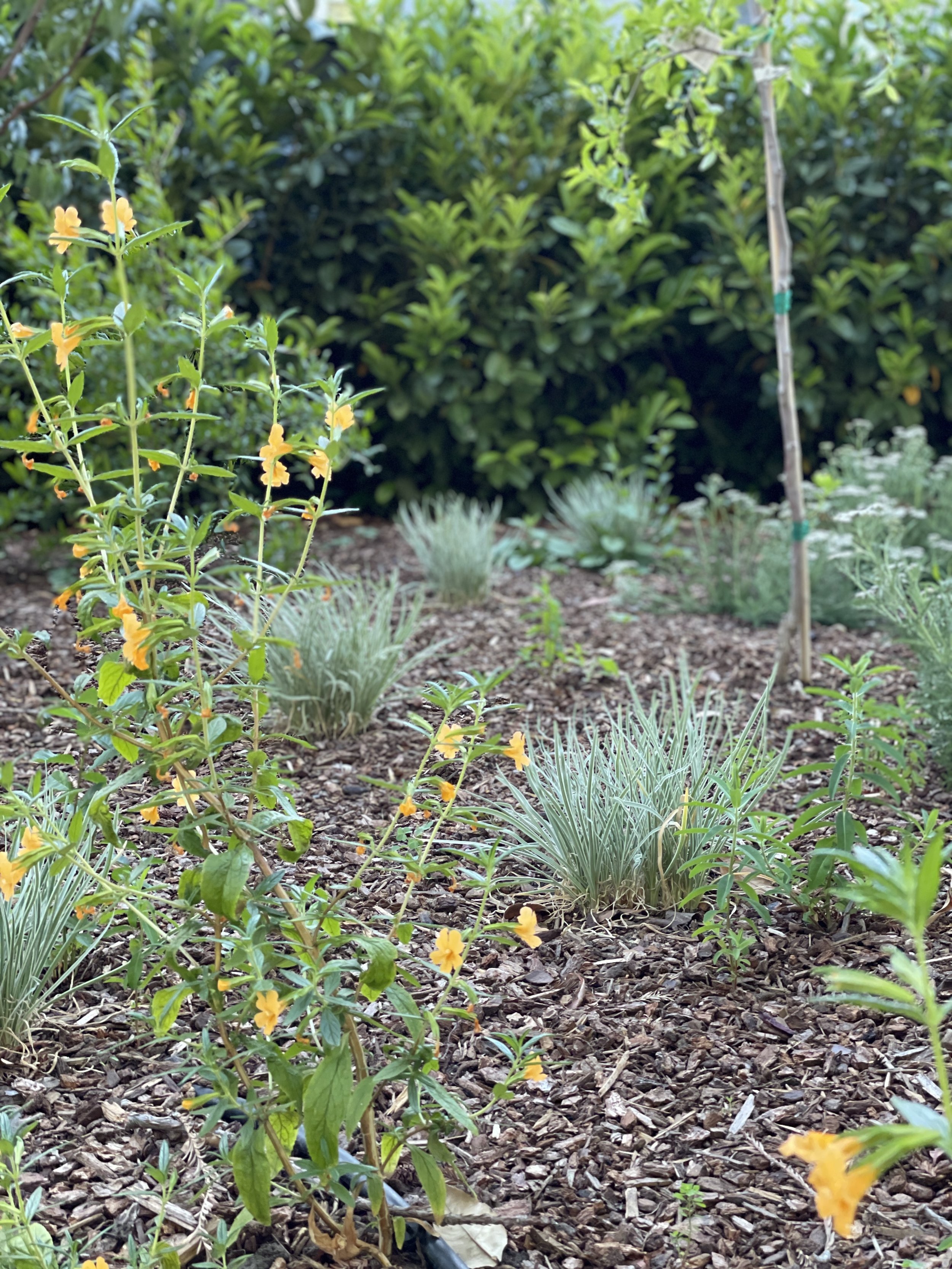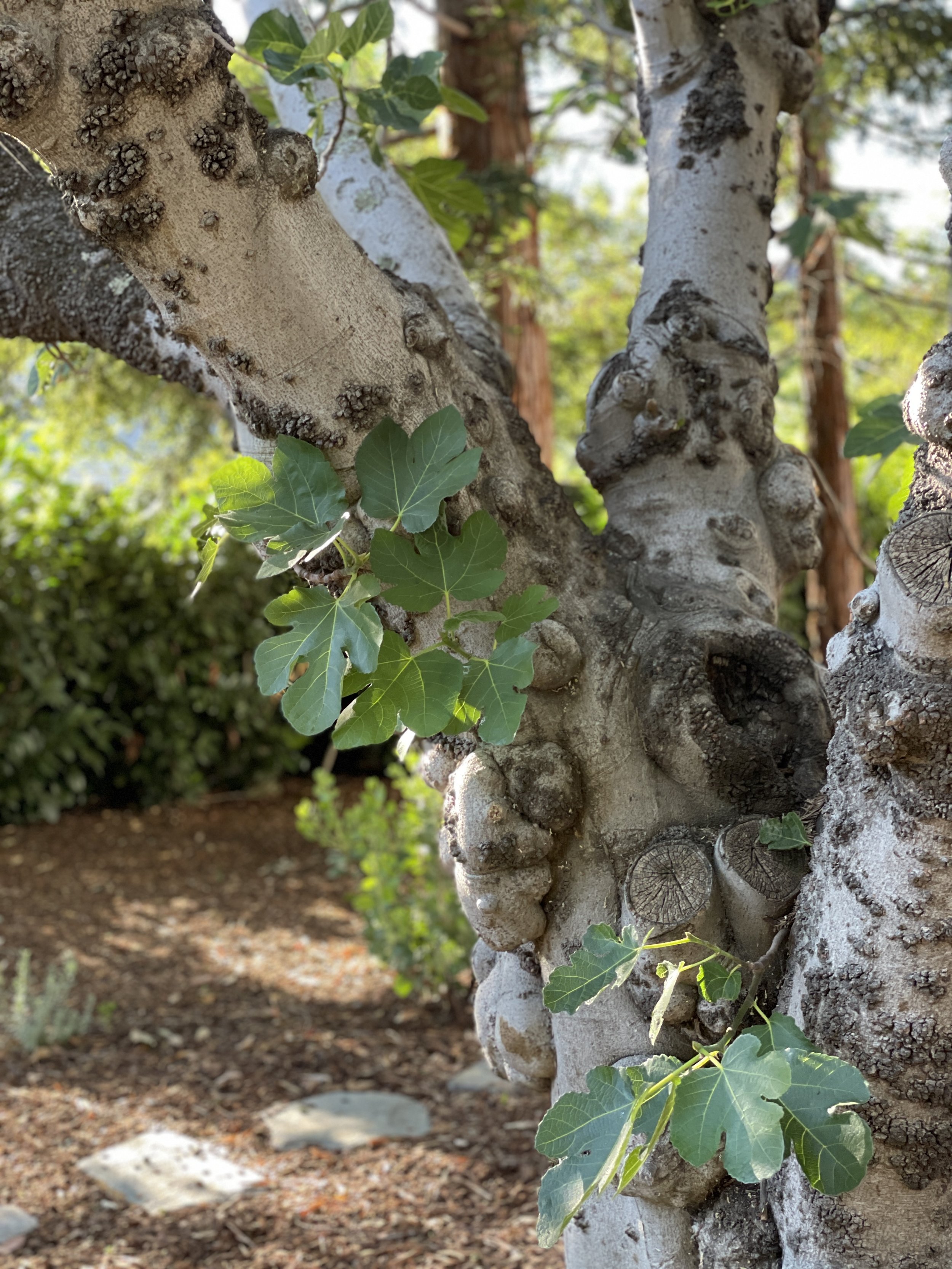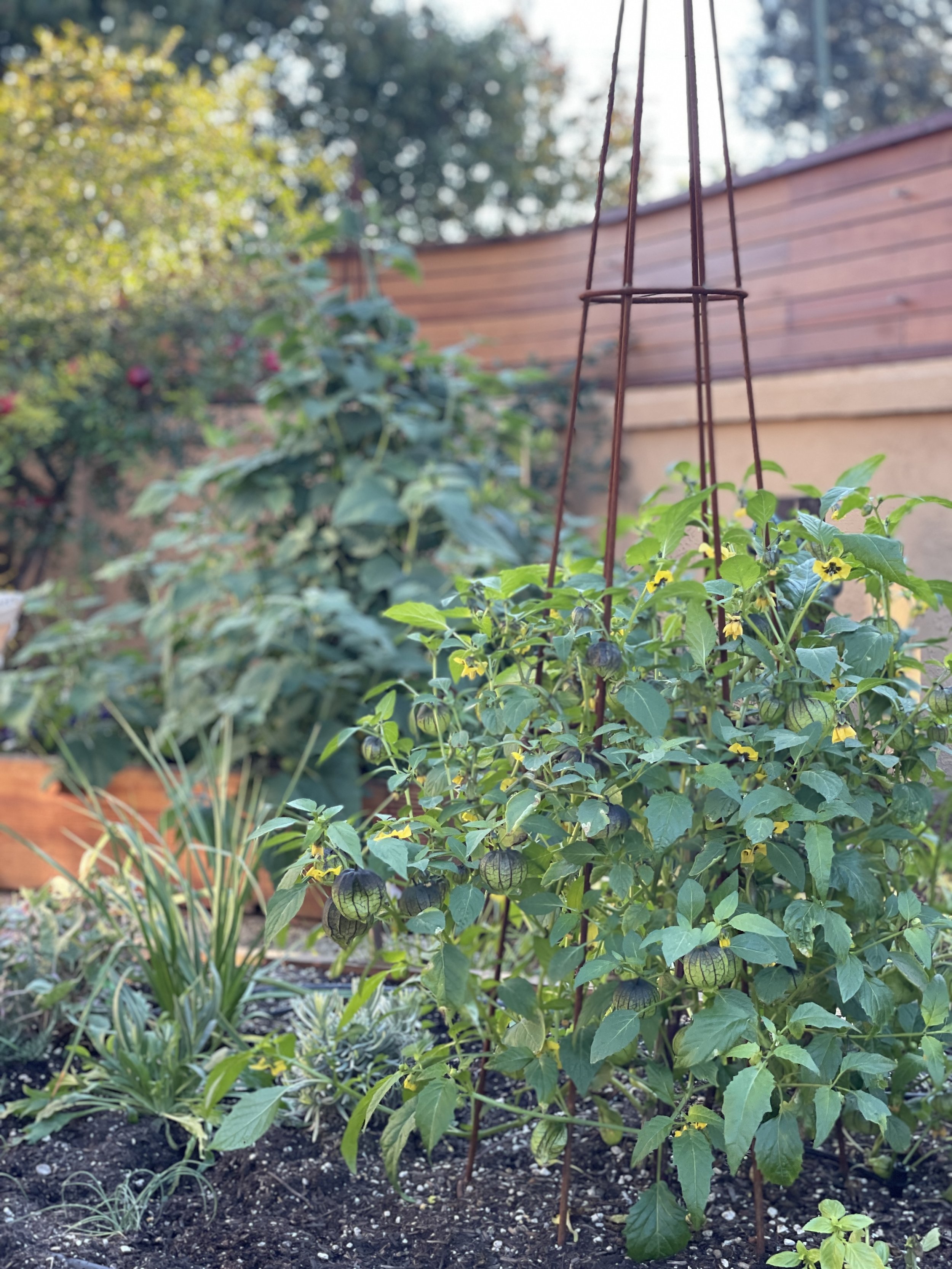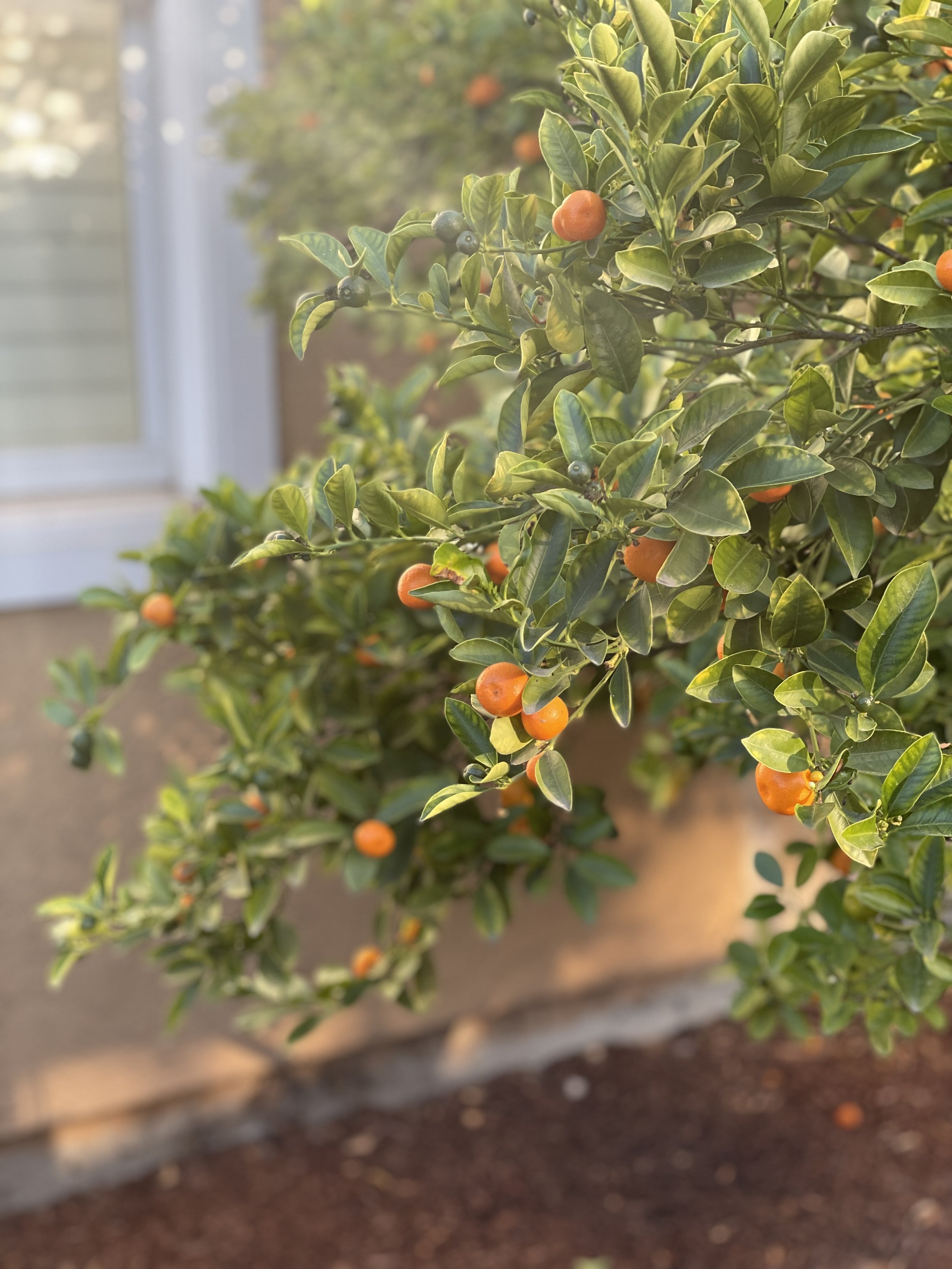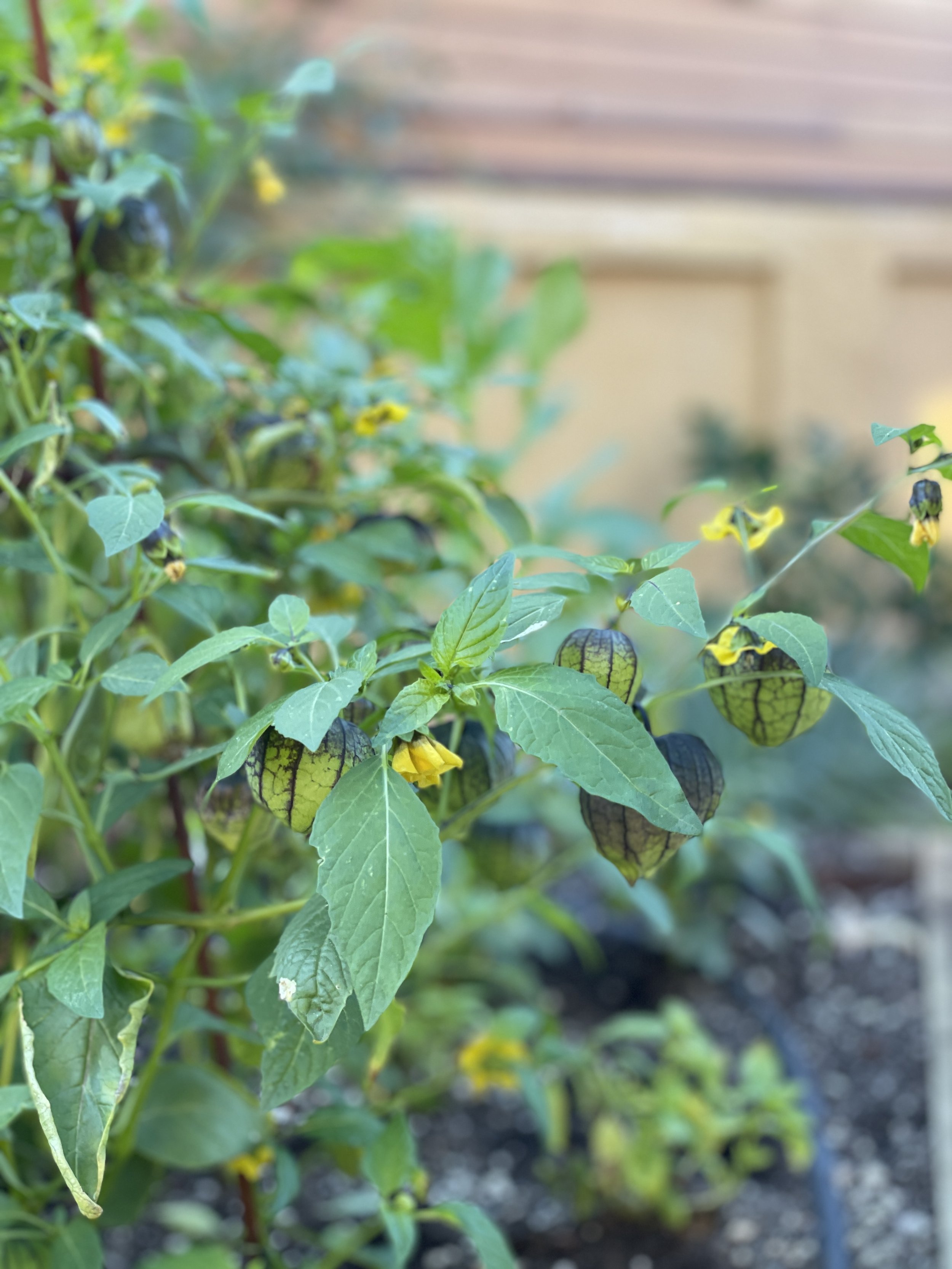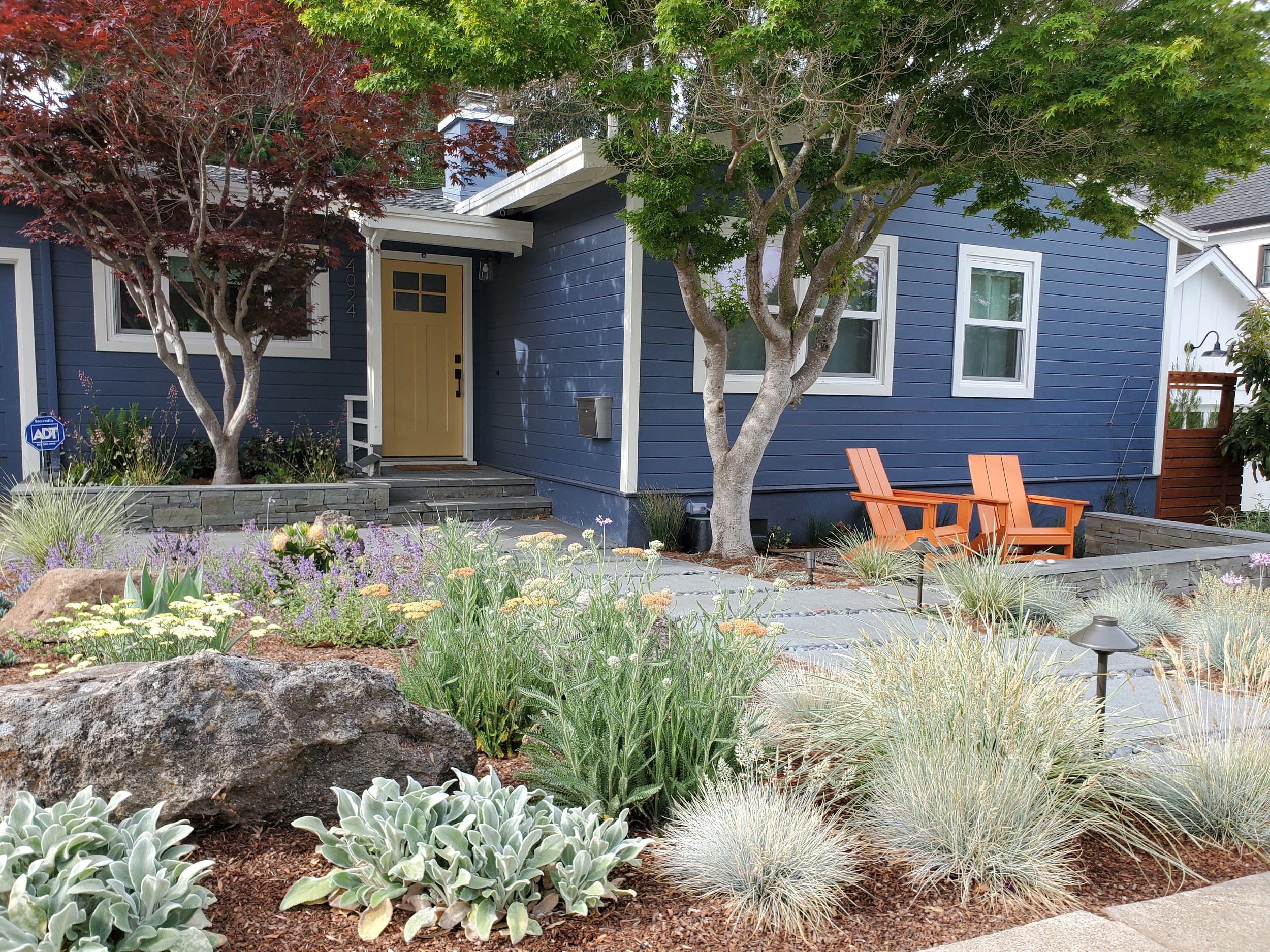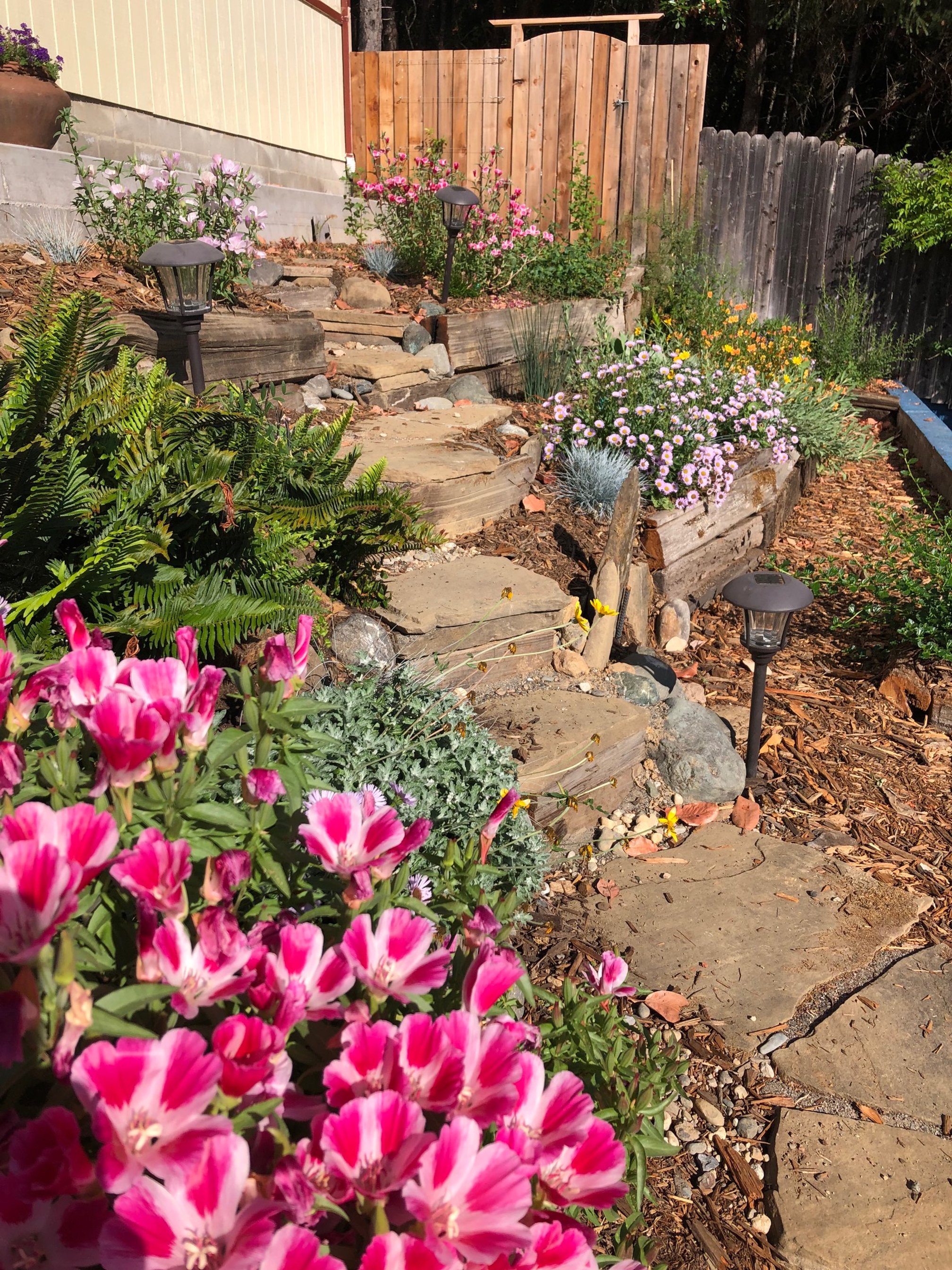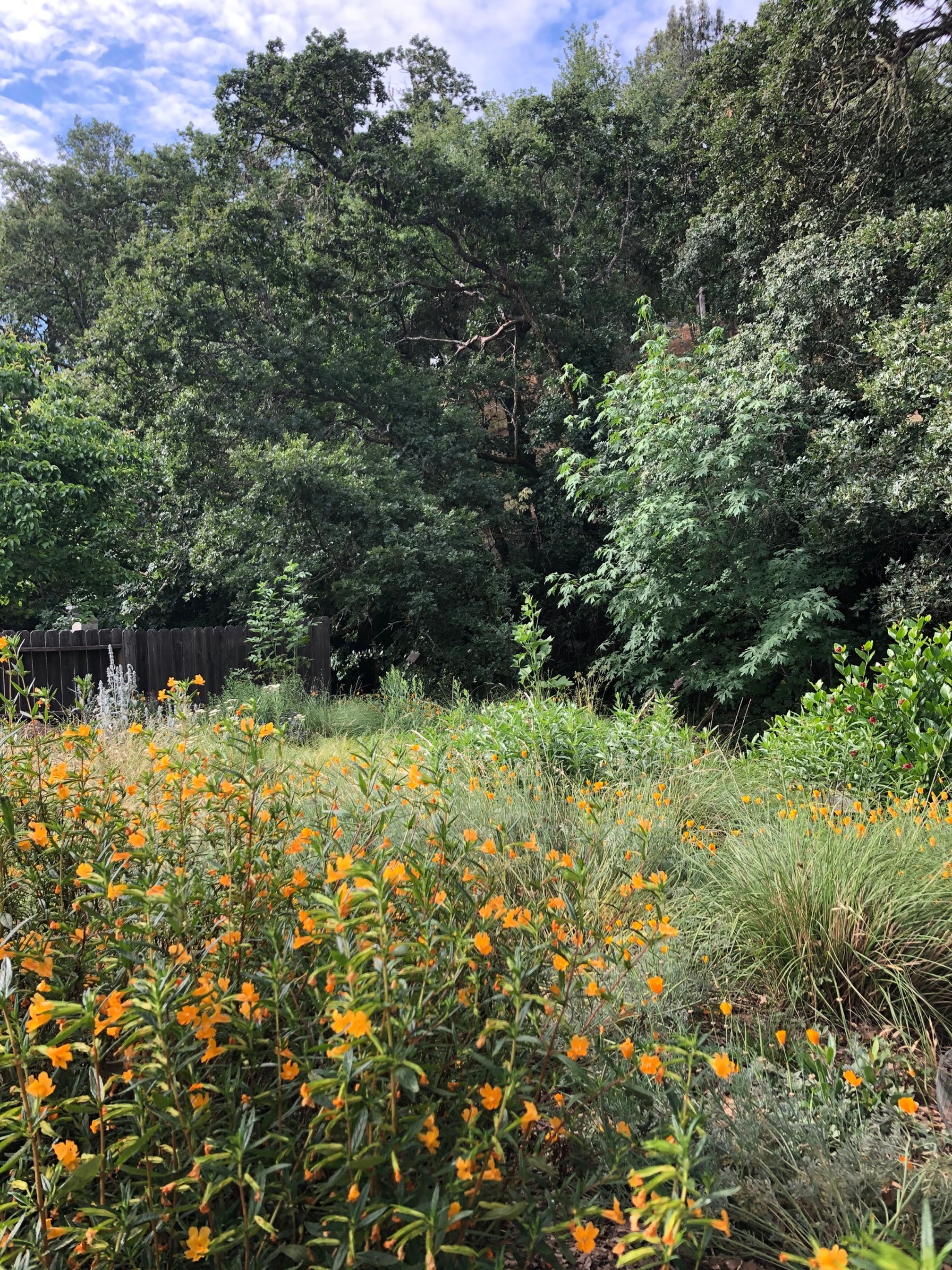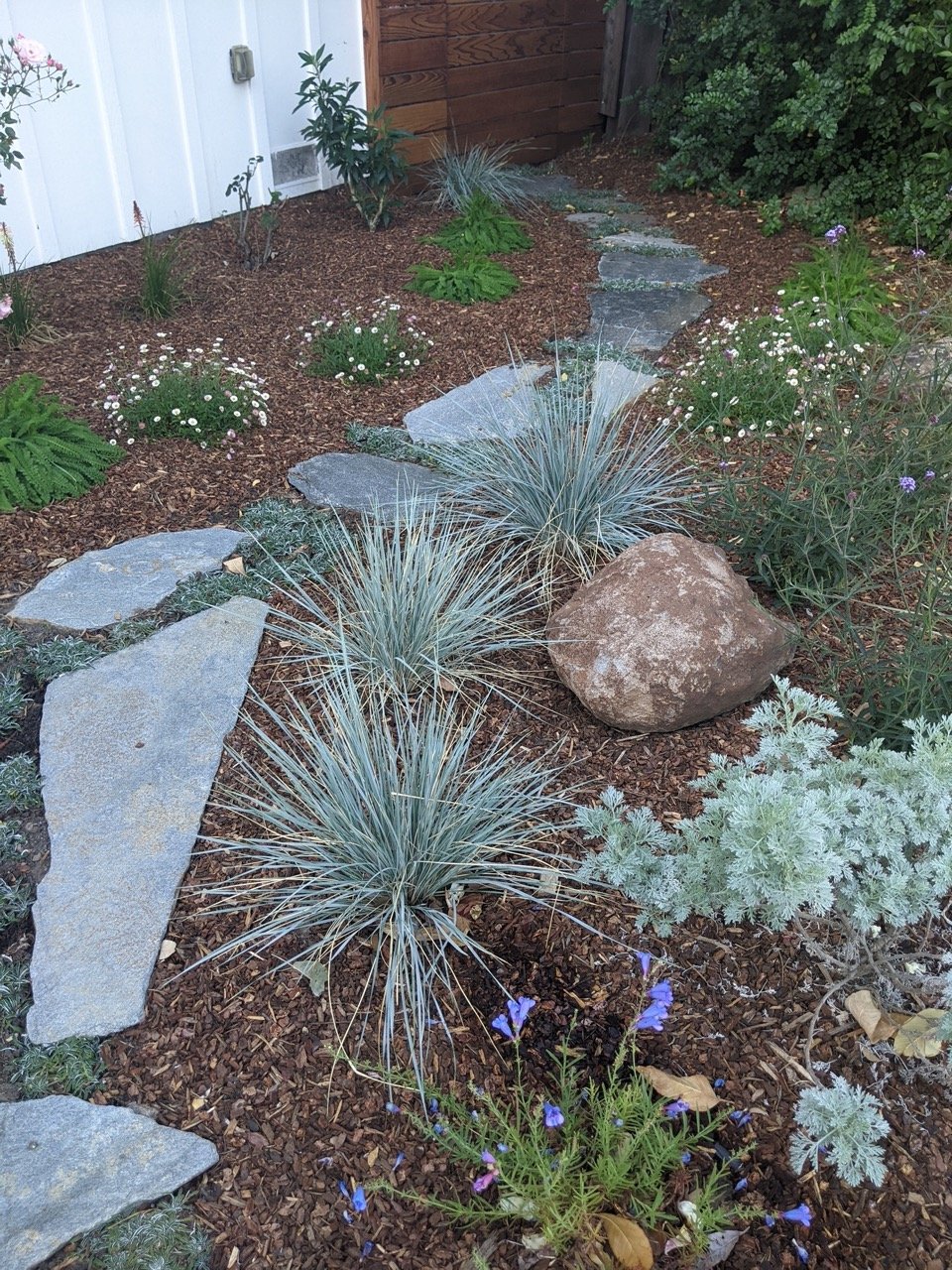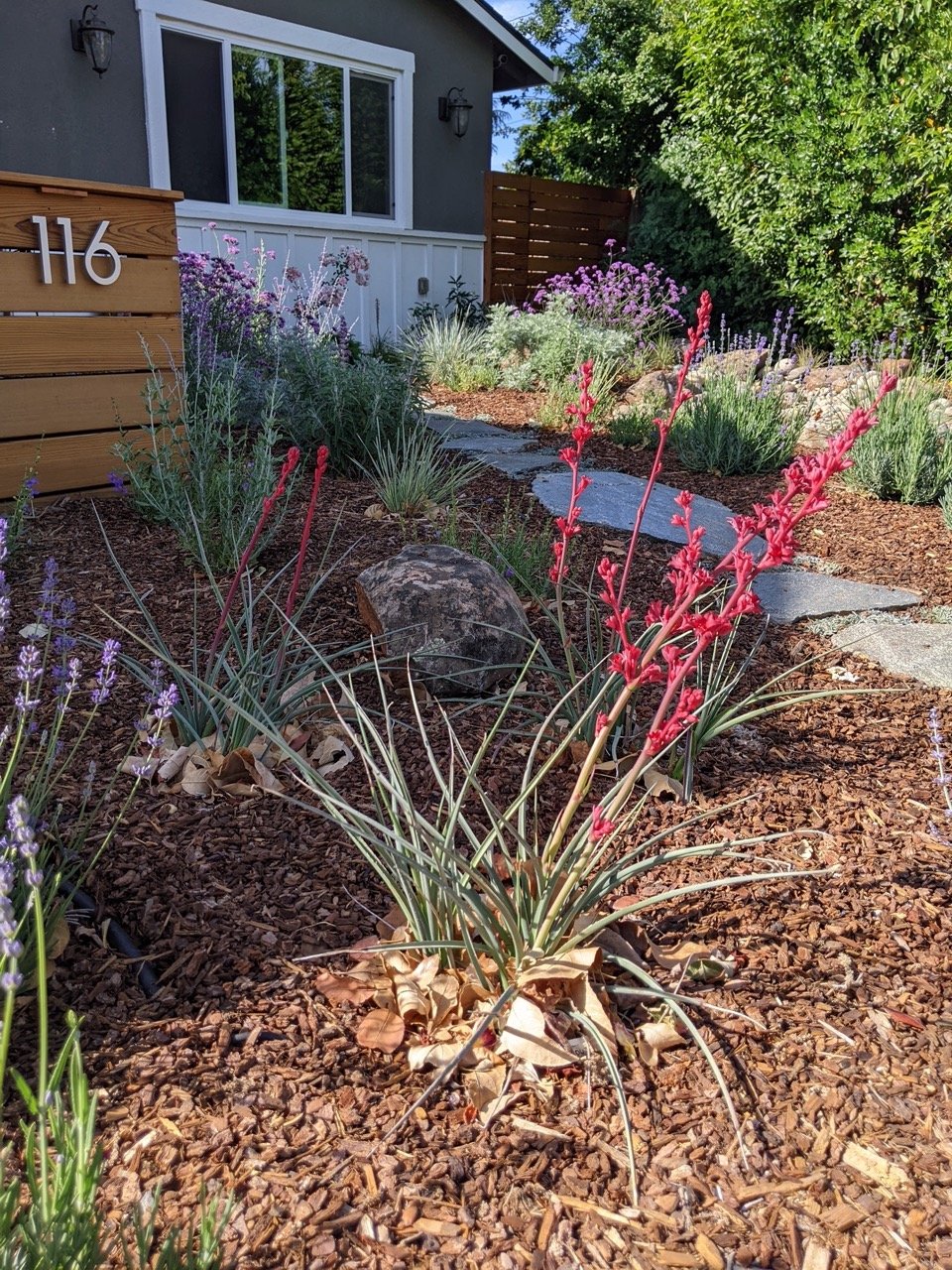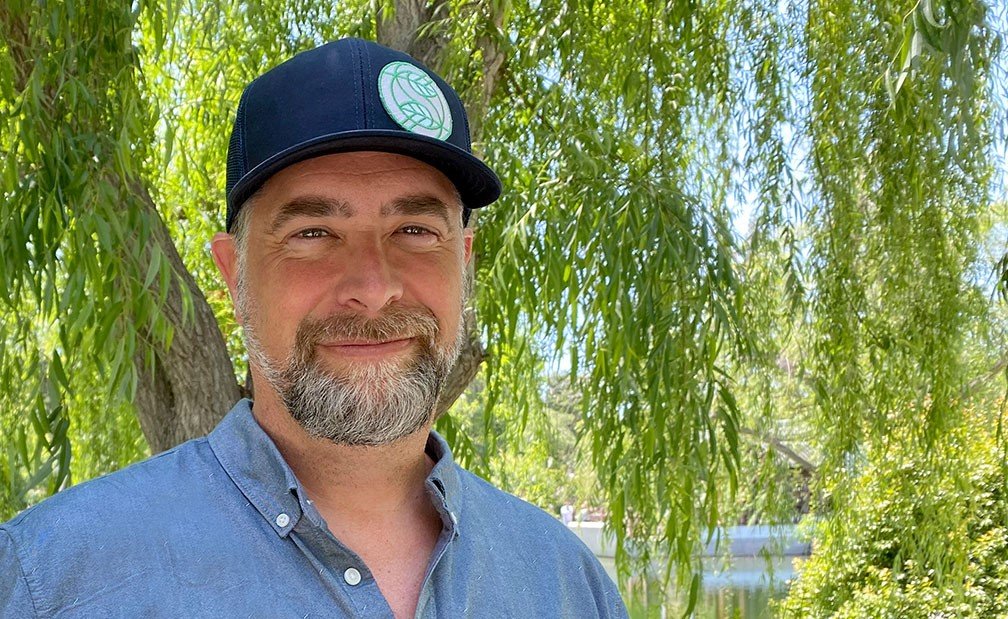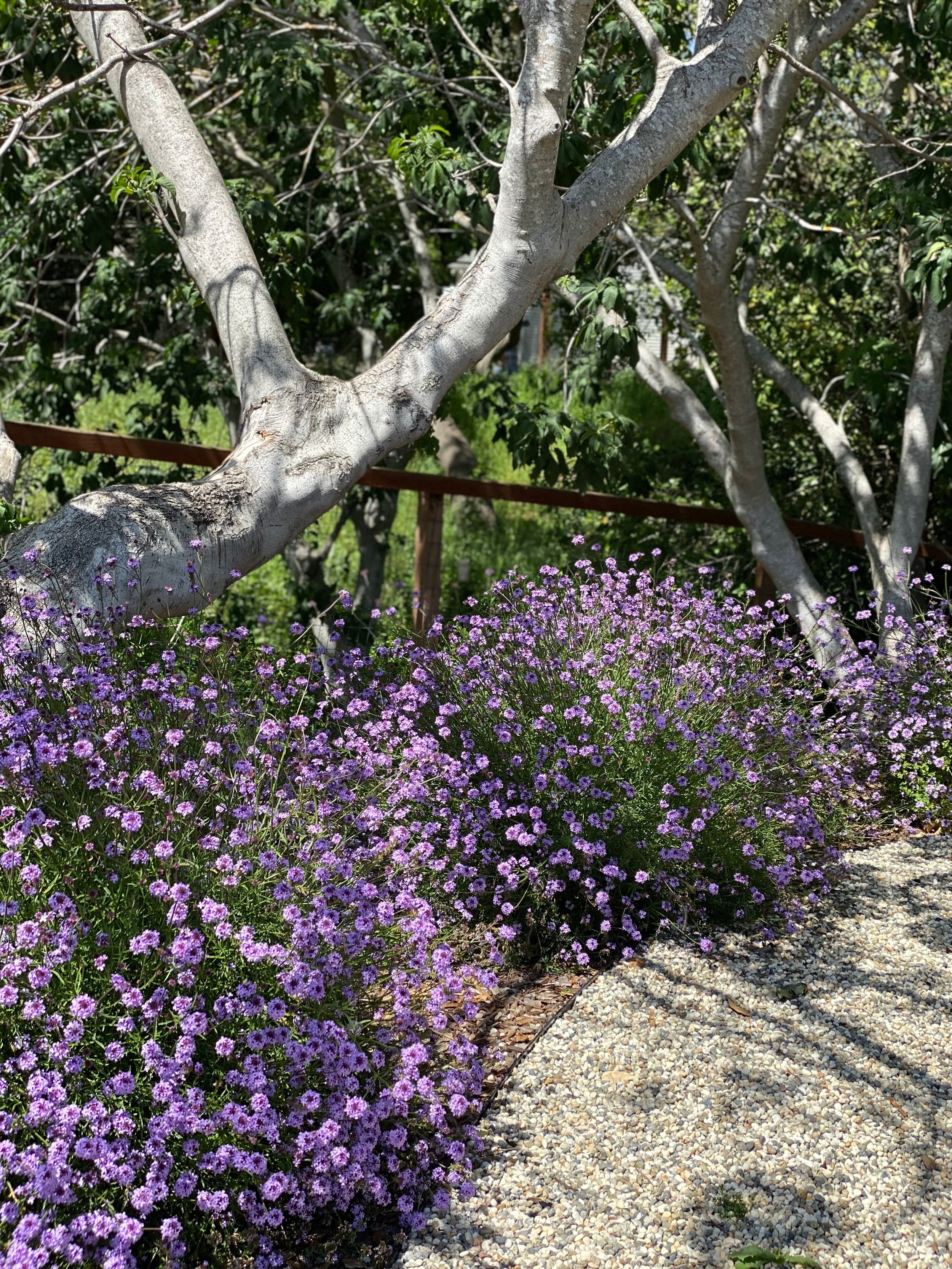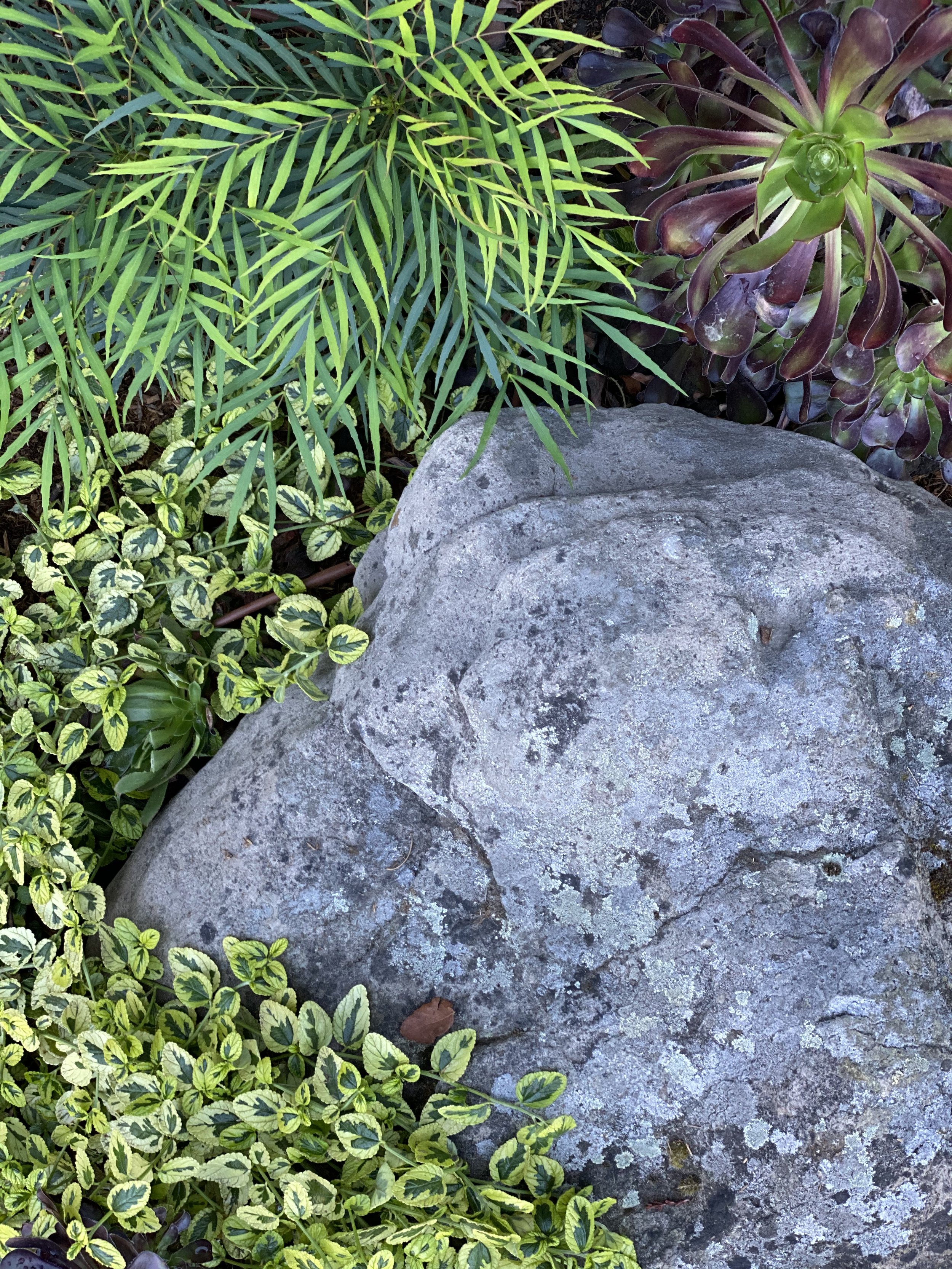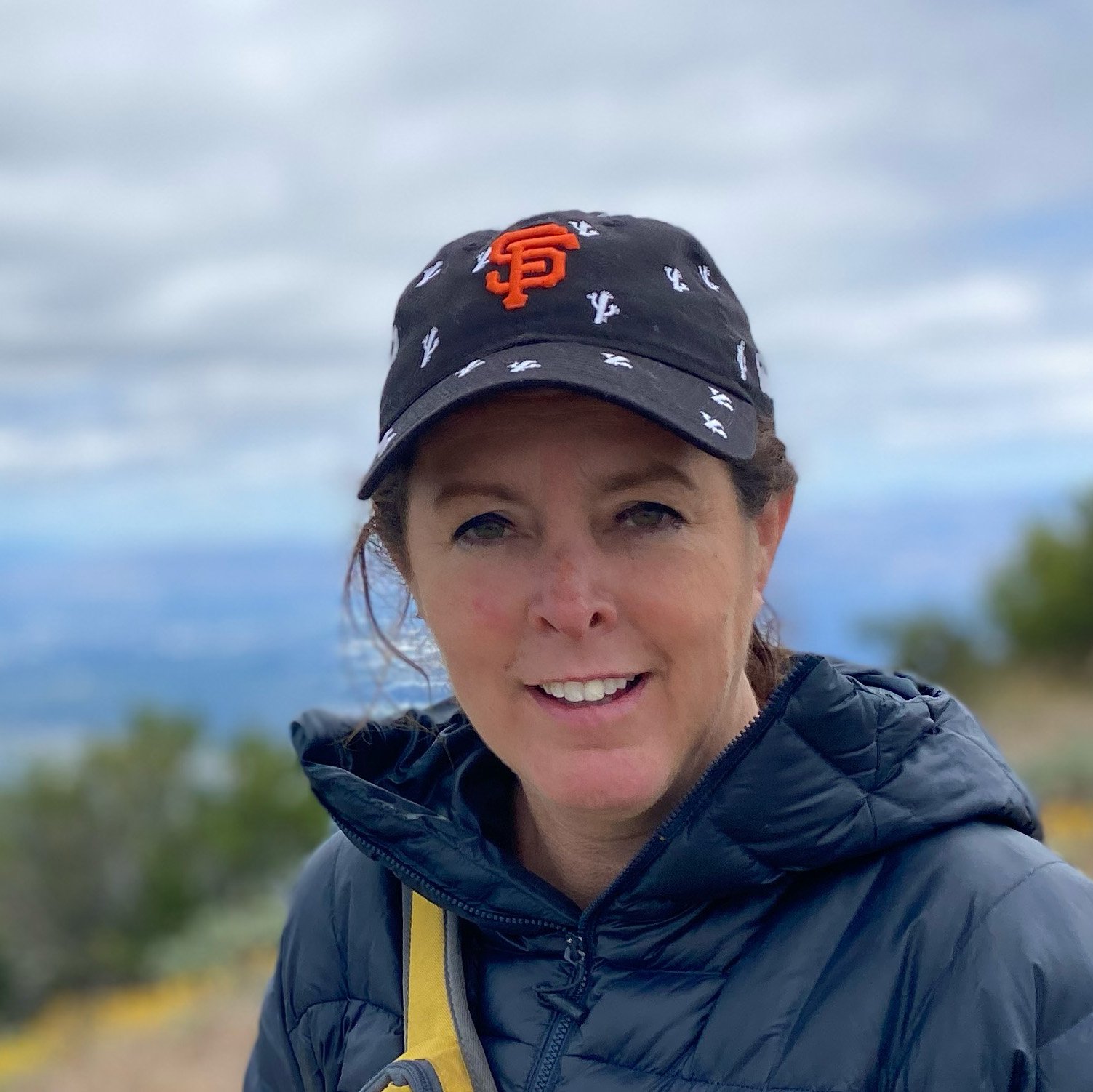Photo courtesy of Karly Silicani.
THE NEXT GENERATION OF LANDSCAPE DESIGNERS
We’ve reached out to designers in different stages in their careers to get their thoughts on where the profession is headed.
Emerging Professional Designers: The APLD membership category “Emerging Professional” refers to individuals who have been practicing landscape design for less than three years. We’ve contacted a few and asked them a bit about themselves.
Donna Bodine BeeLand Farms
El Cerrito, CA
During the early onset of the pandemic, I decided to end my career as an environmental scientist working in private consulting and start my second career pursing my longtime passion for California native plants and urban farming. In May 2020, my new landscape design business was announced during the virtual Bringing Back the Natives Tour, a tour of native gardens in Alameda and Contra Costa Counties. My own garden has been featured many times since 2011. And so I began designing landscapes consisting only of California native plants and/or areas to grow fruits and vegetables. One of my main goals is to integrate these two components in a way that creates a long-term healthy, productive, and water use efficient environment for the people who use the space as well as key wildlife species such as our native bees. Locating native plants near food crops is a key strategy for integrated pest management for organic gardening because natives attract beneficial insects that prey on insects that damage crops. And of course, choosing the right native plants will bring many species of native bees to the garden. Native bees are better pollinators than honeybees and their presence improves the quality and quantity of urban farm produce.
A coastal section of Eschscholzia californica, Epilobium canum and Gilia capitata are mixed to create an informal garden perfect for relaxing and watching wildlife.
My first design project was a sloped median along historic public pathway in the Berkeley hills. Inspired by the natural setting, I created a Coast Live Oak woodland inspired design plan, drawing on plants that are part of the natural oak woodland community and often grow on slopes. My client lives next to the pathway and implemented the project as a volunteer opportunity. She wanted a variety of leaf textures, pollinator-friendly flower colors, and plants that would extend the blooming season as much as possible.
Susan Choi
Flowerchild Gardens
SF Bay Area, CA
It’s kind of been a short but long journey for me that led me into landscape design. I’ve made tons of mistakes and did all sorts of gimmicky things as an amateur home gardener before seriously considering a landscaping career.
Previously, I was working as a designer for digital experiences and products for ad agencies and tech companies. Feeling burnout, I thought, “I’m going to take a sabbatical for a month!” During that break, I wanted to disconnect from technology, the computer, social media, etc., and I joined a vegetable gardening class to get my mind off of work. This led me to learn more about horticulture, both at Foothill College & Merritt College. I felt better… renewed? To learn something new and unfamiliar to me. Growing up in pretty urban area of So Cal did not give me much exposure to plants or nature. This was all definitely new to me.
I have way more experience as a fine gardener than a landscape designer, having learned a lot from my internships at a few gardens and being part of the gardening staff at Gamble Garden. Working for a couple of landscape design/build/maintain companies rounded things out, particularly my role as a designer/project manager on properties that involved building permits tied to MWELO.
I feel so fortunate to have many mentors (both in gardening and design) and support from friends in our tight community here in the Bay Area. The work of landscape designers/architects like Scott Shrader take my breath away—OMG YES! I also love California so much—it’s a special place and so dang challenging to design for.
Ultimately, I decided I really like being a landscape designer. It’s a lot of problem solving, and plants are simply amazing. When I see my clients spending more time outside, enjoying their spaces and connecting to plants, it makes me happy.
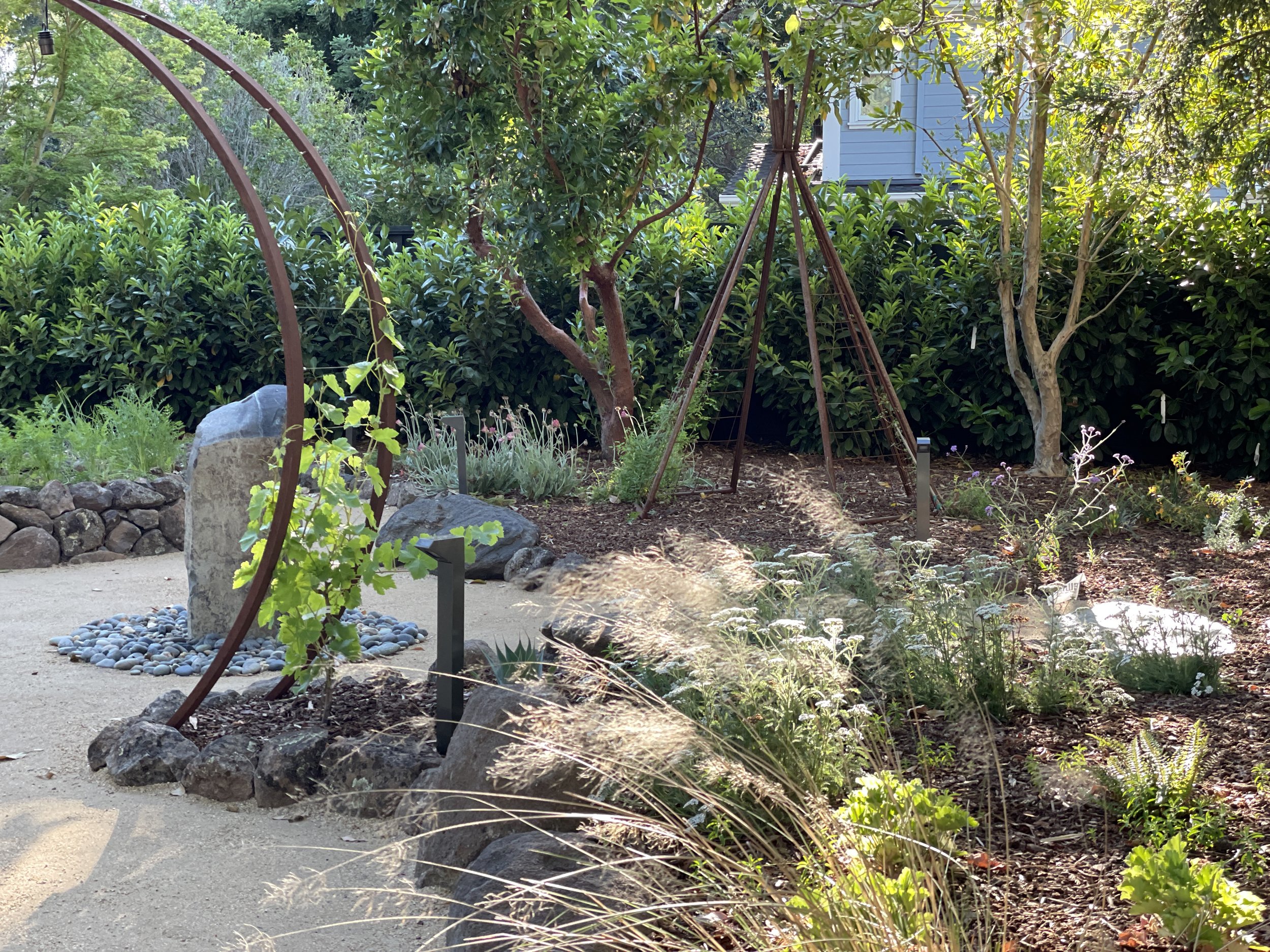
Laura Damsgaard Rootsy Garden Design
Half Moon Bay, CA
Q: What was the moment you realized you had made the transition from student to professional designer (aside from finishing your educational program)? Was there a specific moment when you realized “I am a professional landscape designer”.
A: It was probably the moment I felt confident charging money for my time. While I was studying environmental horticulture, I did a lot of free work for friends, family and neighbors to gain experience—and confidence, really. I took advantage of every educational and hands-on opportunity I could find, and after about two years of work experience, I made the leap of legally filing my business and admitting out loud that I was a landscape designer. It’s been full speed ahead ever since and so much fun.
Q: How has Covid affected the launching of your new career?
A: When everything shut down, we were all really nervous and unsure of what was going to happen. Looking back, I now think one of my fear responses is to get really really busy—because it was during this time that I completely immersed myself in everything horticulture and set my sights on making an official career change. I couldn’t have done it without the amazing support of my family. The four of us created Rootsy together, everything from my then 3-year-old toddler pointing to her favorite logo draft (which is now my logo!) to my teenager helping take photos for the website. And my husband did way more than his fair share to keep the kids fed and the house managed while I sat behind piles of plant books and drafting tools in my makeshift office (a.k.a. our kitchen table). Covid forced all of us to be home together 24/7, which gave me a support network and an opportunity to learn from amazing teachers who were not previously available online. To say it was an intense two years would be an understatement, but Covid presented a unique opportunity for me to nurture the idea of a career change into a reality.
Andrea Davis
Wild Rose Ecodesign
Ukiah, CA
About 2 ½ years ago I made the big leap from working in health care to starting a business in landscape design. My designs are based on sustainable practices and use primarily California native plants. Gardens based on local Northern California natives are alive with movement and sound in a way that non-native gardens cannot be. I rejoice at finding evidence of nature moving into my gardens, such as the curvaceous holes of leaf cutter bees on Redbud leaves, caterpillars munching, adult Lepidoptera fluttering, pollinators great and small, amphibians, reptiles, birds and mammals. California native gardens celebrate the seasons, mirroring the changes of our surrounding wild areas.
I have been inspired by the work of Douglas Tallamy and I consult Calscape frequently for information about the relationships between host plants and the Lepidoptera that rely on them. I love the Dutch Wave style gardens by Piet Oudolf and spend many hours pondering how to translate these into a California fire safe style. I became the Garden Manager for the Grace Hudson Museum Wild Gardens 2 years ago. The Wild Gardens provides opportunities for the public to learn about regional ecosystems, environmental sustainability, and the cultural traditions and land management practices of the Pomo Indians, the original inhabitants of the greater Ukiah Valley. This has led to my increased interest in the cultural uses of native plants. I now include native plant munchies for people as well as wildlife in my designs.
I love this new vocation, filled with beauty, bird song, the scents of Wild Rose, Yerba Buena and Coyote Mint, the sparkle of insects floating above meadows, and the tangy taste of wild strawberries and manzanita berries. I can’t think of anything I’d rather do than create these magical natural places.
Christine Gertner Inviting Gardens Landscape Design & Horticulture
Menlo Park, CA
Christine Gertner is a creative innovator with a long history in art and design. She has trained and dabbled in a variety of disciplines from 2D & 3D fine arts, textiles and even living walls. She always aspires to understand her medium and her mission.
After an early career in fashion and textile design, she had no viable professional options later in life. This reality, although dismal at first, eventually led her into Foothill’s Environmental Landscaping program. She took classes part-time while raising her two children, trained in fine gardening and living wall care. When covid sent the world into lockdown, her front yard became a work-zone, a catharsis, and an opportunity to engage with the dog-walking, work-from-homing neighbors. Two-years out it is a flourishing reminder of the journey. It also launched her onto a series of projects and a solid start as designer for hire.
Christine and her business, Inviting Gardens, are based in Menlo Park, CA. She works flexibly with clients to inform and support them throughout the creative and installation processes. She is particularly inspired by perennial wave gardens, principles of Japanese design, and Californias’a native flora.
A New York native, she has called California home for more than 20 years. She has also proudly raised two college-age children.


Silvia Gramuglia Bay Area Garden Design
Campbell, CA
My journey with plants started as an agronomist mainly doing research in the plant science field (breeding, intensive crop production, plant pathology). Plants have never stopped to amaze me, but back in Argentina (where I am from), I never had the opportunity to develop my passion for landscape design as a career. However, a piece of my heart always remained dreaming of becoming a landscape designer some day.
When my husband and I moved to Europe (England) 15 years ago, it was there where I could indulge in horticulture, design and got spoiled by the frequent visits to the Royal Horticultural Society (RHS) Gardens, Chelsea flower shows and the gorgeous garden centers full of ornamental varieties where I still take inspiration from. In the UK I had the opportunity to continue my studies and put my horticulture knowledge into practice, designing for friends and family in Europe. It always came out so naturally and fulfilling to me, that deep inside I knew I would eventually need to have the courage to change my career path. However, It wasn’t until we moved to California and joined Foothill College that I felt ready to become a landscape designer.
In a way, the pandemic helped my career turn into the direction I always wanted, by giving me that extra push I was needing. During this time, many people realized how important it was to have a space to ‘escape’ from the stressful environments the pandemic had created within their own house, now turned into schools and offices. Many found the answer was in their gardens. The requests for design and consultations were overwhelming during this time. And without even noticing, in 2021 my business took formal shape. I started offering garden and design consultations focusing on growing food in an organic and regenerative way, and by coaching people in their own gardens or on-line as there was a lot of need or interest in ‘do it yourself’ (DIY). I love to transfer the knowledge I have gained through the years of gardening in different countries and weathers, but most importantly for me is to pass on how to apply horticultural practices that help the environment while my clients are ‘growing’.
My design work is based on observing nature. I like to create landscapes that feel natural in their space and tuned into their environment, while at the same time meeting my client's garden needs for beauty and purpose. I work promoting organic and regenerative practices in the landscape that contribute to healing the soil, preserving water in place and providing a safe space for wildlife and its diversity incorporating low water needs and California native plants as much as I can.
Many designers are part of my daily inspiration: Christian Douglas, Stefani Bittner and Leslie Bennett, Rosalind Creasy (influencing my Edible landscape journey). Piet Oudolf, Nigel Dunnett, Dan Pearson, Andy Sturgeon and Bernard Trainor (For their naturalistic approach, so close to my heart).
Being a landscape designer makes me feel accomplished and hopeful. If through my love for plants and nature I can transmit and contribute to people reconnecting with the land where they are growing their gardens, then for me it is the most rewarding experience I can have. I then would be able to feel I have contributed to nurture our beautiful Planet, even if it is one garden at a time.

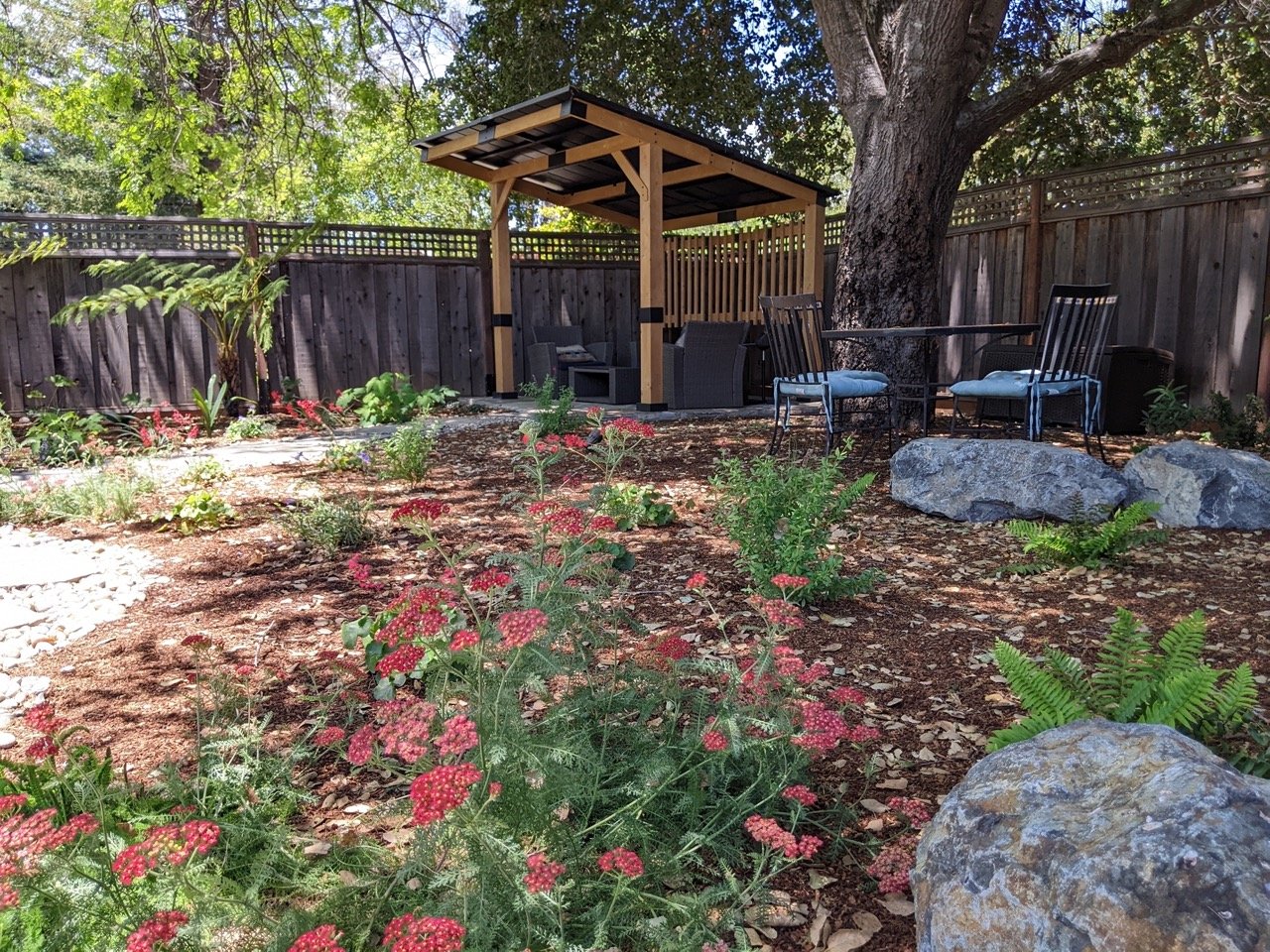
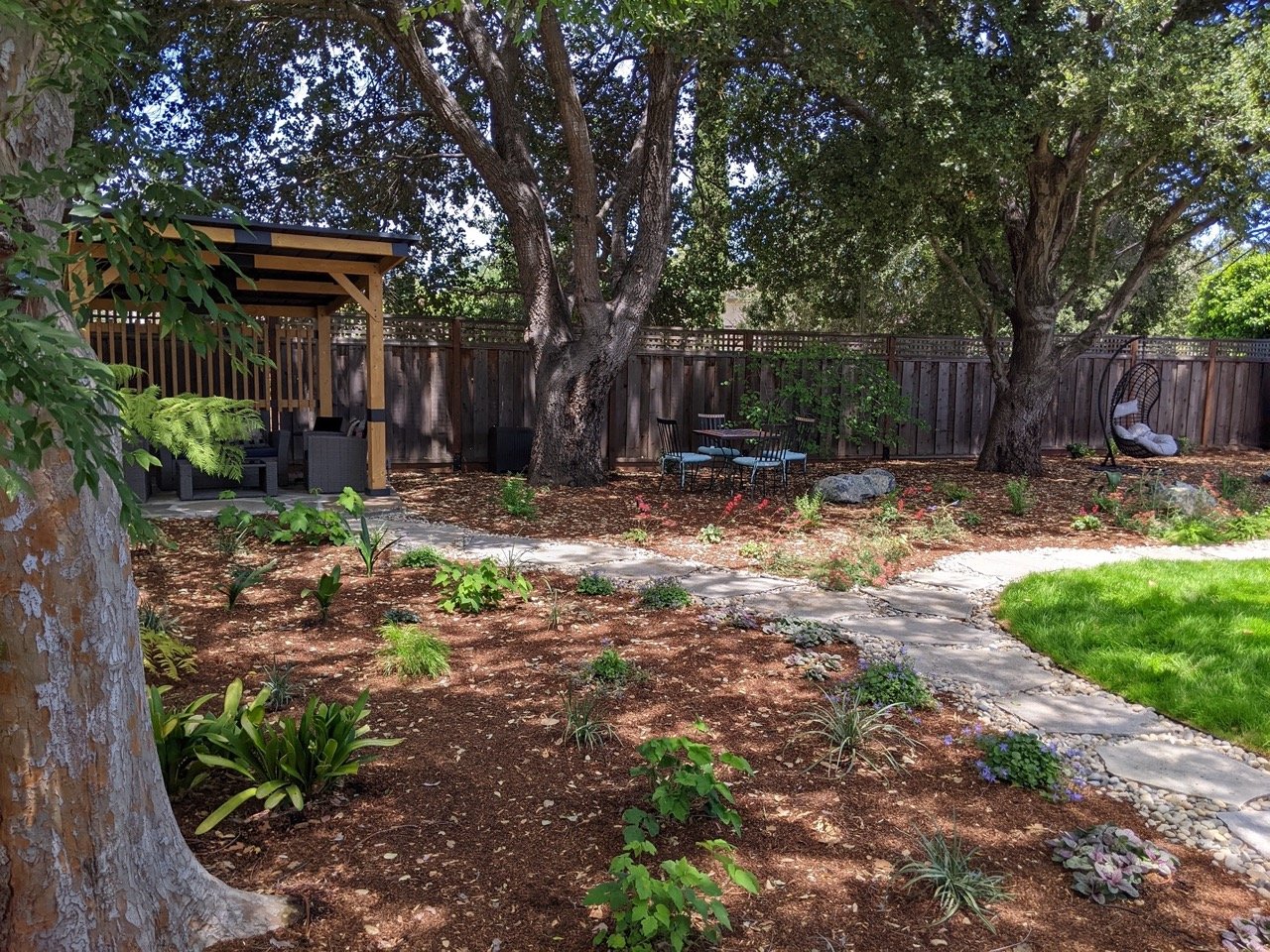
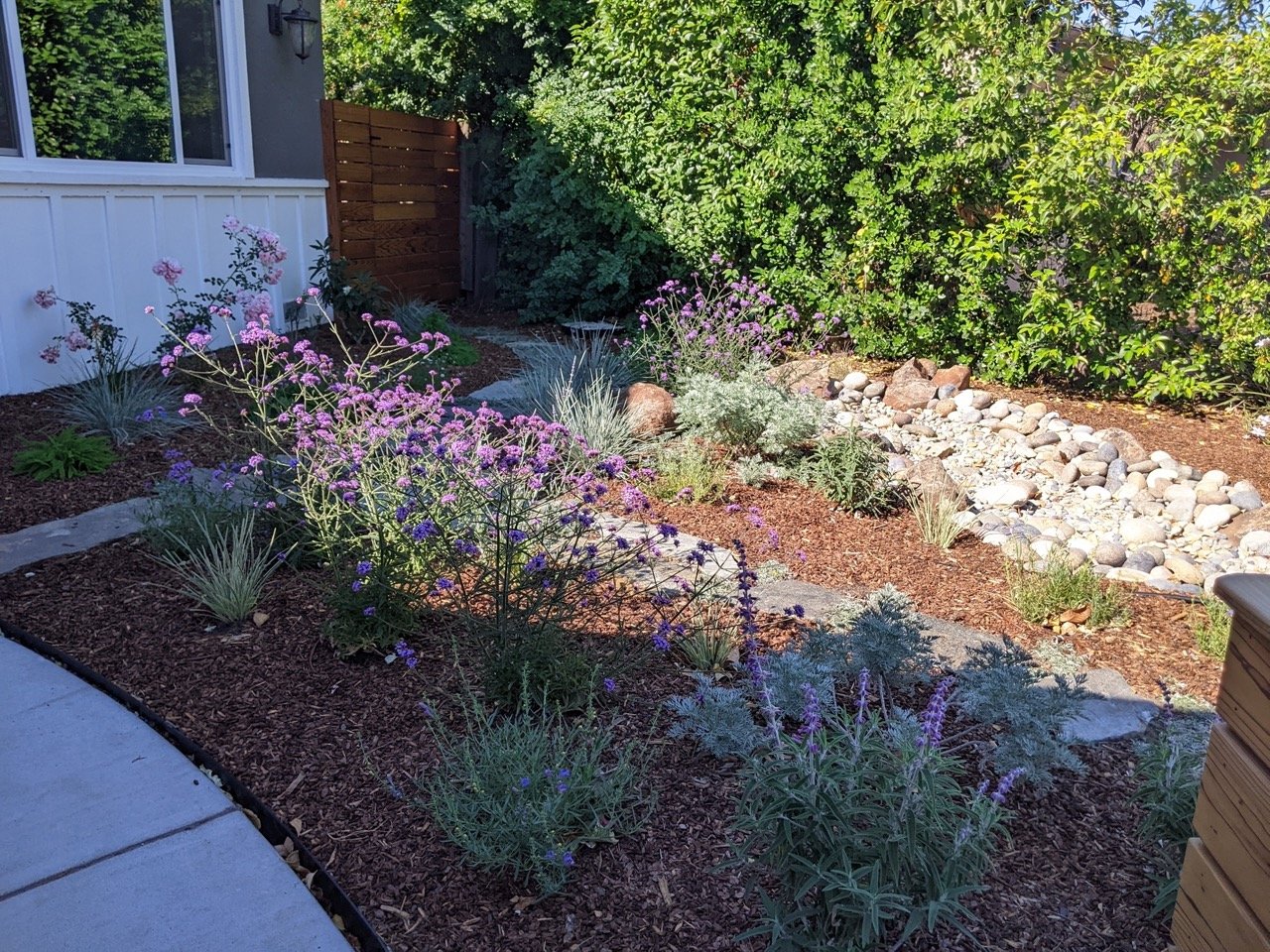
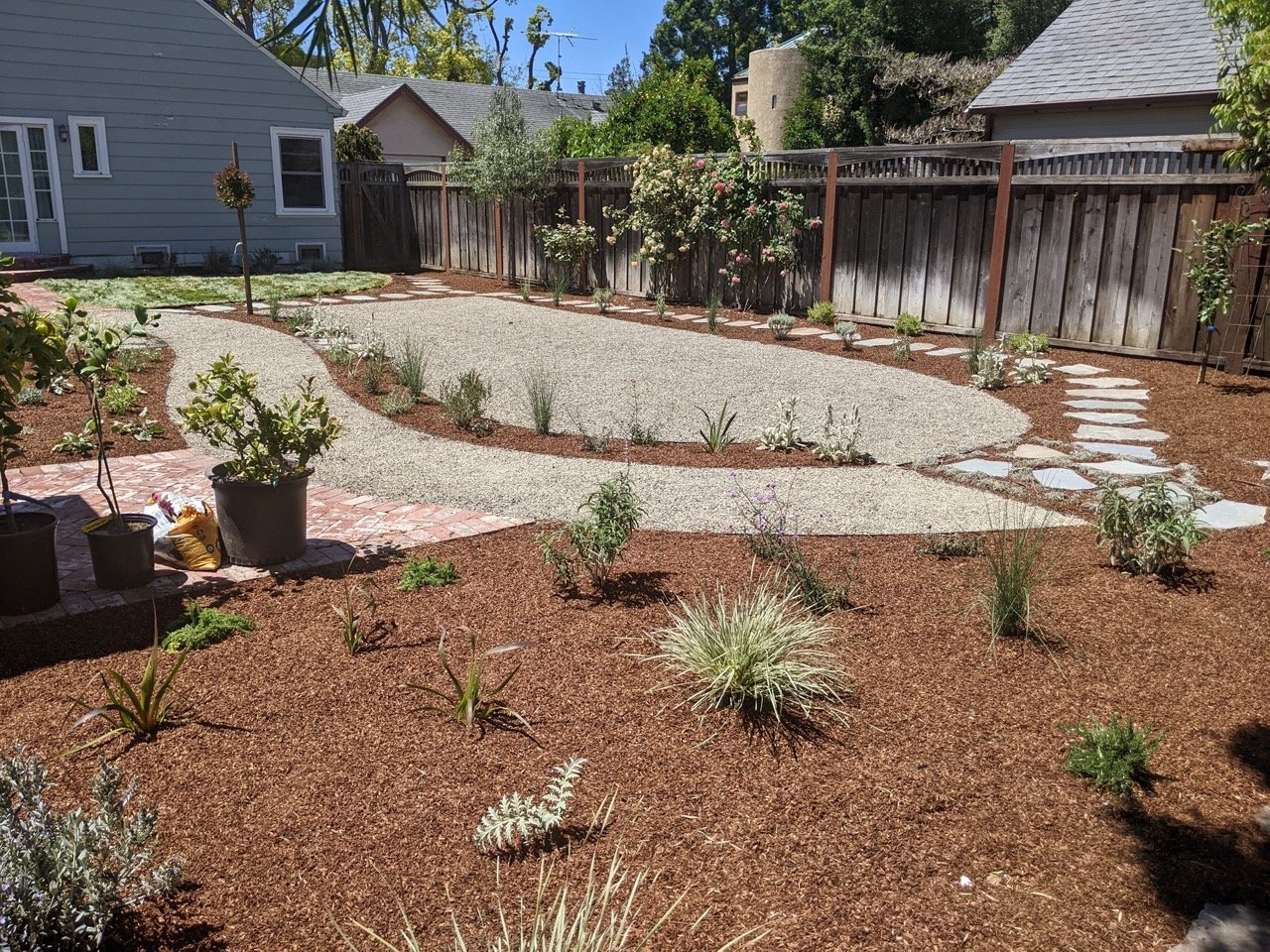
Kent Mitchell
Outer Spaces Exterior Design
Long Beach, CA
It’s a wonderful thing to wake up every morning excited to start my work as a landscape designer. I love everything about what I do—every aspect—from strategizing with clients to hunkering down in front of the computer for hours. When I recognized this enthusiasm in myself, I knew I had found something I would enjoy calling my career for the rest of my life.
Three years ago I would never have guessed I would be doing this. I had recently quit my job, having spent decades running an advertising design agency. I was playing the stay-at-home-dad role while I explored what my work future might look like. In the meantime, I began working in the backyard. I designed a master plan for our outdoor space and began building retaining walls and an elevated deck. It was my first such venture, but I pushed the boundaries of design and engineering. Once complete, the results were positive and the feedback I received was great. I soon found myself craving to be back outside doing more. That’s when I decided becoming a legit landscape designer might be worth pursuing.
I absorbed as much content as I could, approached friends and started putting together designs for free to get some experience and work samples. Feedback continued to be great and so off I went. Despite being relatively new to this, I now have a waiting list of clients.
Outer Spaces Exterior Design provides outdoor design, space planning, and facade makeovers. Every project is different; every client is unique. Drawing from my experience in advertising/marketing, my client engagements begin with a comprehensive discovery process to draw out what my clients really need and want from their outdoor spaces. This leads to a highly tailored landscape design that clients feel truly represents what they want—even if they were unable to communicate what they wanted initially. My goal is to leave my clients so excited about the design that they can’t wait to pick up a shovel and get started.
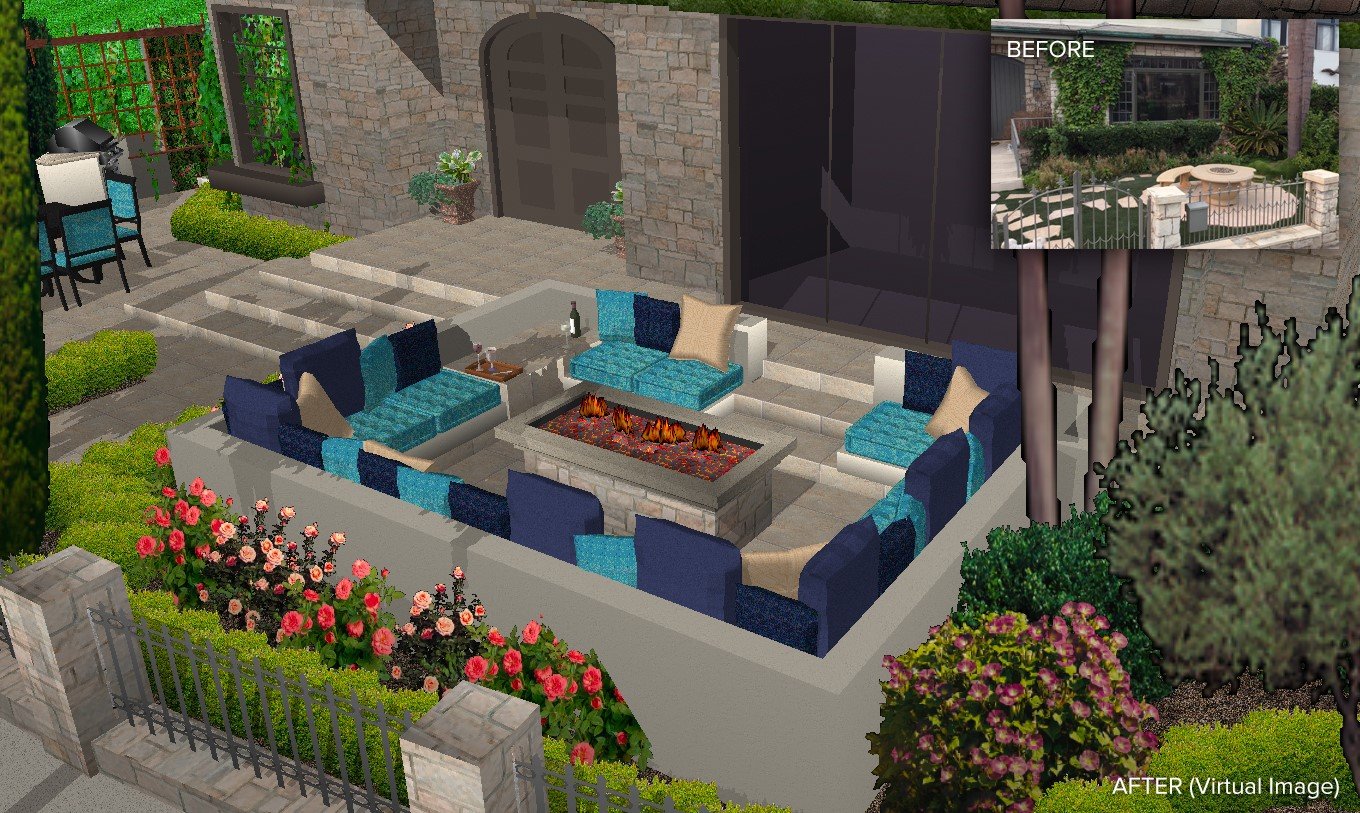
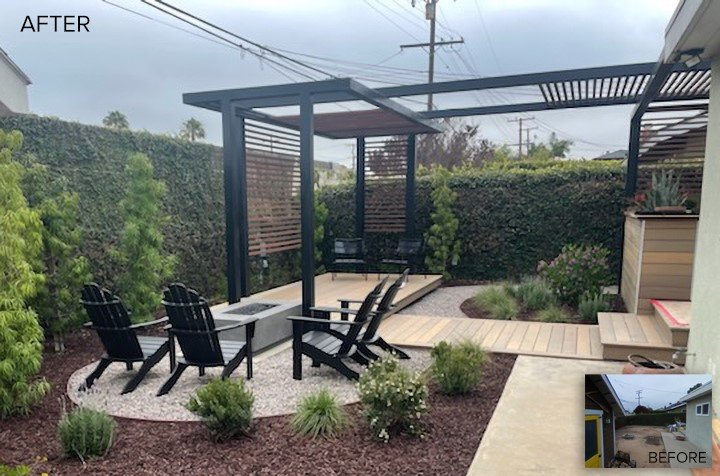


Karly Silicani
Silicani Landscape Design LLC
Lafayette, CA
Landscape design wasn’t my first “calling.” A difficult postpartum experience with my first child forced me to better prioritize my mental health, and perhaps not coincidentally, make an exit from the corporate world.
In the years prior, gardening had become somewhat of an obsession and I began to embrace my creativity as a “maker” in order to fulfill my desire for involvement in something more creative than my professional experience. Landscape design seemed like an incredible leap of faith and the only “right” choice at the same time. I spent a couple of wonderful and transformative years back in school (Merritt College) then crept back into the workforce as a newly minted landscape designer.
I graduated with my first college degree at the height of the economic crisis in 2008 and my experience the second time around could not have been any more different. Since starting my business in 2019, it’s been an absolute non-stop, drink from the fire hose experience. From my first project, referrals have flowed and my network from Merritt College has paid dividends in the form of mentors, friends and jobs. I do not take this abundance for granted and often cherish the realization that I am, in fact, getting paid to do things like a perspective sketch, peruse inspiration images or best of all, purchase plants.
One of the things I appreciate most about this field is infinite opportunities to hone my skills and grow my knowledge base in such diverse creative, scientific and social subject matter. As the daughter of a retired schoolteacher, the addiction to lifelong learning runs deep in my blood.
I could spend countless hours fueling my knowledge of plants (Janet Sluis is quite the inspiration) or diving into the latest garden design books. However, the social impact of our role as garden designers is a primary source of meaning for me in this work.
My first “calling” and passion was in the field of international development, with a specific focus on the promotion of democratic governance in sub-Saharan Africa. I worked with an organization closely tied with USAID project implementation and still carry a deep passion for social justice. My ability to speak French doesn’t directly serve me in landscape design but I’ve spent a year now slowly learning Spanish so I can better acknowledge, respect and communicate with many of my counterparts in this field.
I greatly admire the work of Terremoto and others in extending their mission beyond our shared and important goals of creating beautiful gardens, increasing biodiversity and reducing water use. They are prompting difficult and honest conversations around the imbalance of power and recognition in our field. These efforts make me proud to be a part of this field and give me a deeper sense of purpose in my daily work.
My goal for the future is to grow as a designer, help educate clients about our collective impact with our gardens and play a greater role in advocating for our hardworking partners in construction and installation.
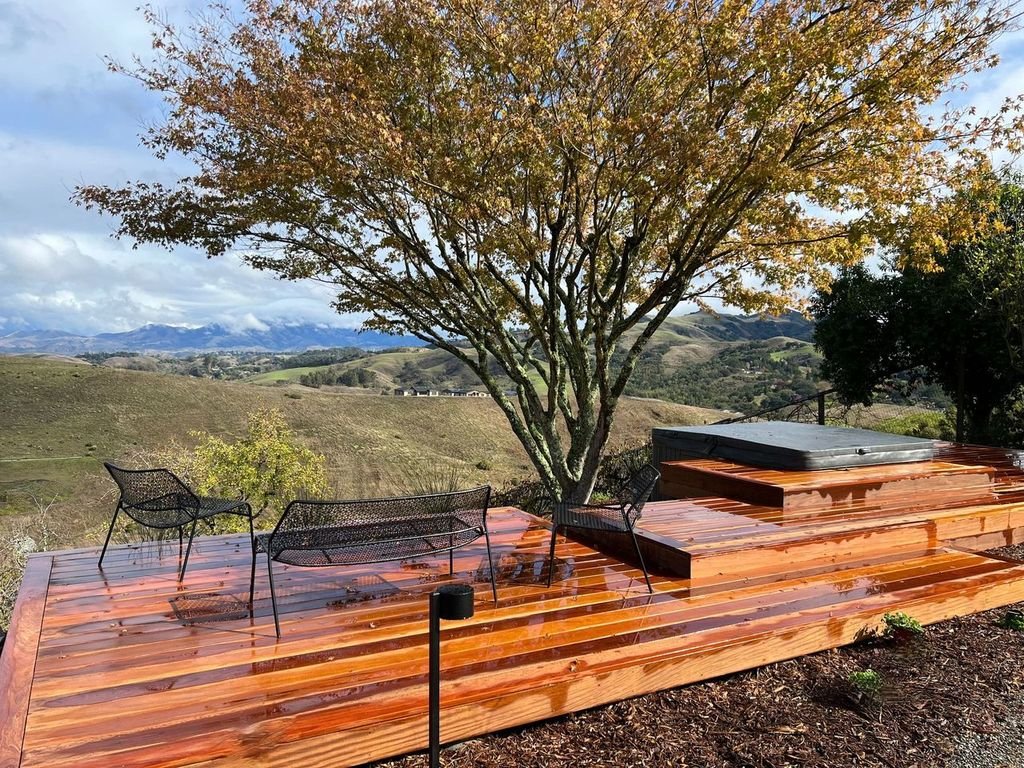
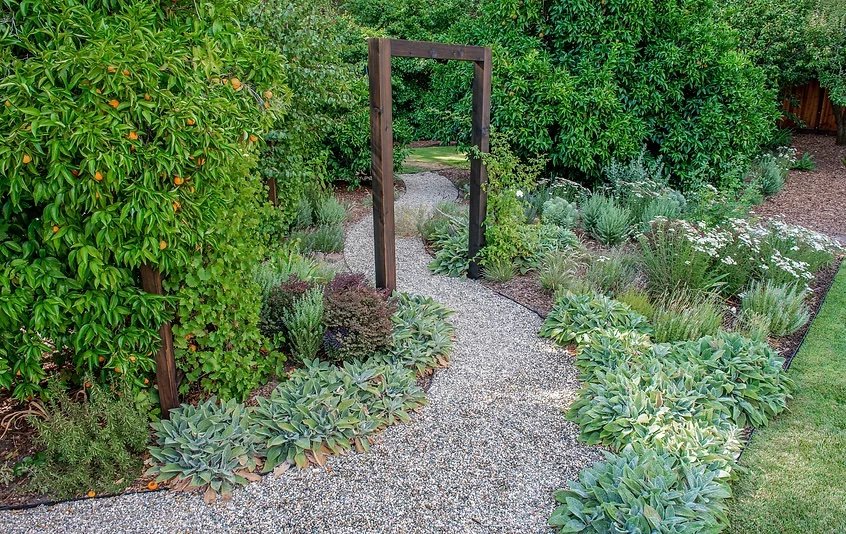
Joshua Stangby Stangby Designs
Fresno, CA
Q: What was the moment that realized you had made the transition from student to professional designer (aside from finishing your educational program)?
A: The moment when I realized that I was a professional designer was during my first consultation with a client. I remember insecurity running through my veins. The thoughts of how I am going to do, replayed over and over again as I went through my client brief. The classes I took, and time I spent preparing didn’t truly get me ready for the moment when a client and her husband were talking about their yard, and the goals that they had. At that moment, something clicked as we sat down in our chairs and I asked to take a look at their space. Once, we got outside and I saw how their vision would play out the fears and doubts kind of melted away as we began to discuss their lifestyle and how we were going to plan their space out to accommodate their lifestyle and goals. Once, I finished the appointment, and finalized the contract to be commissioned for the landscape design. I felt very accomplished, and also a responsibility to honor their space, and request. The point in which I was able to embrace the insecurity, and turn it into a tool to better serve my client, is when that ‘aha moment’ hit me , me being a professional landscape designer. That same doubt and fear still exist, but I find it to be a useful tool that stretches the imagination, and helps push the design process forward in a positive direction.
Q: How has Covid affected the launching of your new career?
A: The effects of Covid have caused a massive increase in business that I could’ve never imagined! Covid has served as such a unique transitional point in a business as a whole. Before Covid, I was a professional athlete playing football in Canada. Covid canceled our whole season, which caused me to transition into landscape design full-time. [It was then that] I made the decision to commit full-time to developing and growing my landscape design business. It seemed everyone was at home, spending more time together, and focussing on what they prioritized. A backyard that was previously neglected before covid could no longer wait for people who were forced to live at home. I think the protocols to keep people home really started to generate conversations at home amongst people. Homeowners started to ask themselves how they could turn their backyard into more functional outdoor living spaces. That, in combination with not being able to see people frequently, caused our society to value nature for its innate beauty far more than it did before Covid. People wanted a more practical outdoor living space that catered to their needs. Landscape design is a perfect avenue to explore solutions for homeowners. I’m very excited to see increased growth in the landscape design industry, as it is such an underrated and underutilized profession.
Student Members: The APLD membership “Student” category refers to members who are actively enrolled in a landscape design, landscape architecture or horticulture program. We’ve checked in with them to see where they are headed.
Rebecca Atwell Palo Alto, CA
Q: Where are you studying Landscape Design currently?
A: Foothill College's program in Environmental Horticulture
Q: What influenced you to explore a career in landscape design?
A: My passion for designing with California native plants began to spread from my own small garden into friends' gardens. I took on a few test projects for friends and neighbors—designing, installing and planting, and in some cases maintaining—and each time I finished one, I found myself ready and eager to learn more.
Q: What do you hope to accomplish with your training in landscape design (i.e special areas of interest or career goals)?
A: I hope to design and build ornamental native habitat gardens in urban and suburban spaces in the Peninsula.
Q: What do you most hope to learn by the time you finish your education?
A: I want to learn how to make the absolute most of onsite resources and materials, from the existing soil to water retention to reuse of construction debris.
Colleen Cochran
Altadena, CA
Q: Where are you studying Landscape Design currently?
A: At present, I am completing my thesis for my Master’s in Landscape Architecture at Cal Poly Pomona. My thesis is investigating the intersection between public space and the fields of landscape architecture and landscape design, specifically the attitudes of landscape professionals in Los Angeles County relating to their role, if any, regarding social justice issues, especially the issue of homelessness, and the attitudes of the homeless population regarding the landscape.
Q: What influenced you to explore a career in LD?
A :The natural world has always had a profound attraction for me and the rare opportunities I had to explore it as a child left an indelible imprint. While living in Paris as a young student studying French language and political science, I found myself entranced by the design of the public spaces and gardens in that country. They were egalitarian, welcoming, and beautiful. Their design was also persuasive. “Come, stroll, and take your ease” they seemed to say and I could never resist them, even when I was late for class! Despite the strict design of some of the spaces, I nevertheless found myself luxuriating in a slower tempo and lulled into a calmer state of mind. A testament to the power of good design!
Q: What do you hope to accomplish with your training in LD?
A: Landscape design to me is essential to the improvement of the quality of life. I hope to create beautiful garden spaces for all kinds of people in all kinds of neighborhoods. Just imagine what our communities could be if everyone had a garden in which to live, breathe deeply, and ponder life’s mysteries!
Sarah Cornwell
Palo Alto, CA
Q: Where are you studying Landscape Design currently?
A: I am currently studying Horticulture Design at Foothill College in Los Altos Hills, CA. I plan to be finished with the certificate program in Spring 2023.
Q: What influenced you to explore a career in LD?
A: I’ve always loved studying horticulture and my education is now building on that. I hope to retain as much plant identification knowledge as possible but the botanical name memorization has been very vigorous.
I’ve just completed a Design Process class. My final project was a presentation demonstrating how I would turn two shallow rooftop gardens into 1. a tea garden with fresh herbs that can be picked and built-in handicap-accessible folding tables and 2. a meditation garden with a walking labyrinth. Both low-maintenance gardens are filled with sun-loving natives, grasses, and herbs.
I’m grateful to be a member of the APLD and have all the educational opportunities that the association offers.
Q: What influenced you to explore a career in LD?
A: I’m coming into the career as a second career because my passion has always been gardening and creating inviting spaces for my friends and family. As I become more and more knowledgeable on native gardening and gardening for pollinators, I think I get as much joy out of watching native bees, hummingbirds, and butterflies enjoy the garden as much as people.
Living in Silicon Valley has influenced me. You can make mistakes and try new things. I’m eager to apply my startup technical and marketing background to a career in horticulture and see where that leads me.
Mari Jozaki
Los Gatos, CA
Q: Where are you studying Landscape Design currently?
A: I am at Foothill College located in Los Altos Hills.
Q: What influenced you to explore a career in LD?
A: I found the horticulture program at Foothill College when I was trying to change my career and had a light bulb moment. As many people who are involved in horticulture have in common one way or another, my grandparents were avid gardeners, and they planted a seed in me to love working with plants. As I take more classes, my instructors made me realize the dynamic nature of the landscape design and how rewarding it may be as a career.
Q: What do you hope to accomplish with your training in LD (i.e special areas of interest or career goals)?
A: Pandemic forced us to get along with the space we had then. Even in the most anxiety ridden, crazy times, I appreciated and felt at ease when I went to the favorite corner of my yard. I would love to make residential outdoor spaces the place of joy, and all the good things in life for clients. I believe that includes being responsible and as sustainable as possible for the space you occupy and beyond. I hope to one day be able to design space clients deserve while being aware of the ecosystem we are in.
Q: What do you most hope to learn by the time you finish your education?
A: One of the most surprising facts I learned since I started studying is, how wide breadth the subject you must be well versed in to be a successful landscape designer. The more I learn, the more I know I don’t know. I hope to acquire sources, network of people, and tools I trust to revert to when I get stuck by the time I finish my education. The rest, I suspect is going to be learning process forever.
Alissa Kaufmann
San Rafael, CA
Q: Where are you studying Landscape Design currently?
A: I am excited to say that I have just graduated from Merritt College in Oakland with an Associates of Arts Degree in Landscape Architecture.
Q: What influenced you to explore a career in LD?
A: I have always known I wanted my forever job to involve being outdoors, hands-on, and creative. I used to jokingly say to my friends that I wanted to make a “fairy garden” for myself in the future. When I went to a career counselor and told her all of this, she immediately came up with Landscape Architecture and when I heard it, I thought it could not have been a more perfect job for me.
Q: What do you hope to accomplish with your training in LD (i.e special areas of interest or career goals)?
A: My hope is to one day have my own design/ build firm for residential gardens. The goal is to create beautiful, functional spaces that benefit the ecosystem and that the client will love. Also, from the start of my interest in Landscape Design, I have wanted to integrate edible foods into the design. I think it is not only important that we grow our own food, but it is also beautiful in the garden. Not to mention yummy!
Q: What do you most hope to learn by the time you finish your education?
A: I feel like Merritt has given me all the tools I need to be successful entering the Landscape Design field and I am excited to learn more from real life job experience!
Molly Webb
Oakland, CA
Q: Where are you studying Landscape Design currently?
A: I’m currently finishing up my Landscape Design certification at Merritt College in Oakland, California.
Q: What influenced you to explore a career in LD?
A: I’ve always been passionate about plants, nature and the outdoors, but felt it was something I “should” only do in my spare time. After many years in the client service and project management spheres, I decided that my passion and previous work experience would complement each other and decided to make the leap!
Q: What do you hope to accomplish with your training in LD (i.e special areas of interest or career goals)?
A: I’m really excited to learn as much as I can about design in particular, as I know it is a lifelong pursuit; it’s always so fascinating and inspiring to see how different designers would approach a project. I look forward to partnering and working with landscape designers and small firms so that I can gain as much hands-on experience as I can. My friends tell me that they love to go hiking or for walks with me because they learn about plants that I point out along the way (and I enjoy walking and hiking with THEM because they indulge me when I randomly spot a rare native or interesting plant!) I’d love to take that plant knowledge and apply it.
Q: What do you most hope to learn by the time you finish your education?
A: I have learned so much already – the knowledge of my colleagues and instructors is astounding! – but I hope to further hone my design skills to see how plants with different textures work together. I’m a problem solver by nature, and so I hope that someday I can walk into any garden and see a number of potential solutions for each space. I think when you design a green space for someone, you’re really giving your clients a gift – sometimes that gift is relaxation with an accessible green space, sometimes it’s the gift of wildlife and beauty, and I’d love to be able to provide that gift.


